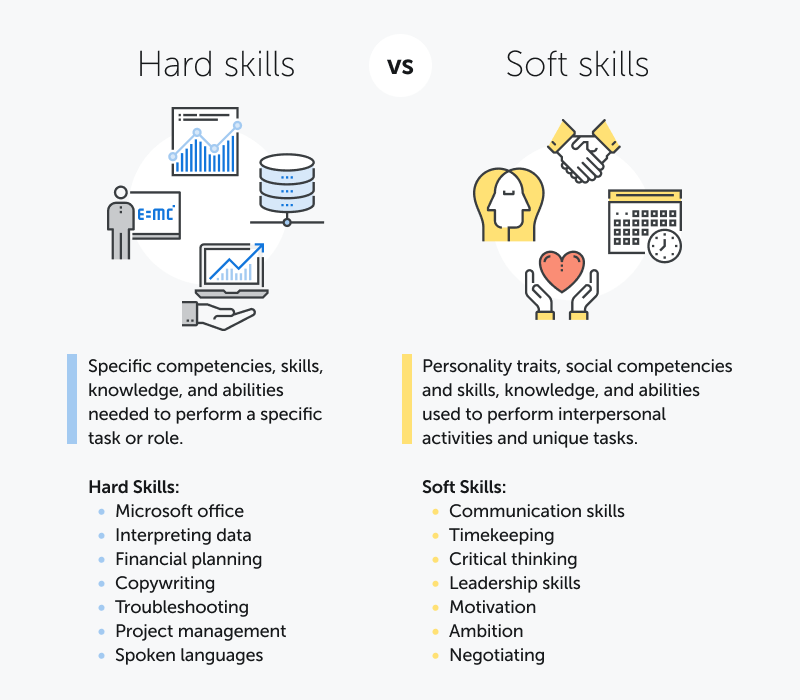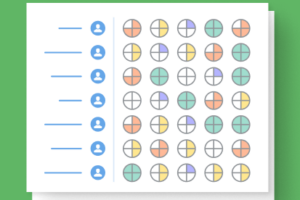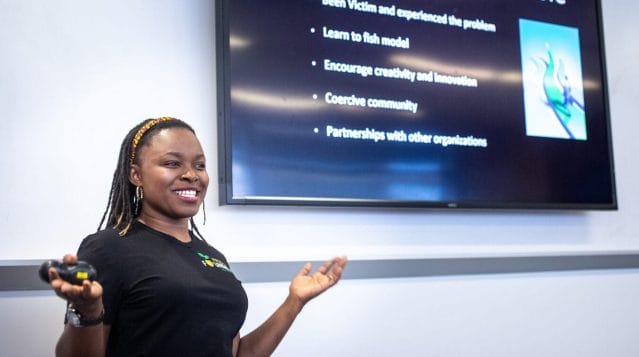- Hard skills
- Soft skills
- Life skills
- People skills
- Social skills
- Privacy Policy
- Terms and Conditions

Problem-Solving Mastery: Your Roadmap to Effective Solutions
- Job Skills , Life skills , Soft skills

In today’s rapidly evolving world, problem-solving skills have become more critical. The ability to identify, analyze, and find effective solutions to complex challenges is highly valued across various domains, including education, business, and personal life. Problem-solving skills empower individuals to overcome obstacles, make informed decisions, and confidently navigate uncertain situations. They are key personal and professional success drivers, enabling individuals to adapt to change, innovate, and seize opportunities.
This article will delve into the essential steps for mastering problem-solving skills. We will explore the characteristics of effective problem solvers and highlight the step-by-step process they follow to tackle problems. From defining the problem and gathering information to evaluating solutions and implementing the chosen course of action, we will cover each stage in detail, providing valuable insights and practical strategies. Additionally, we will discuss various techniques and tools that can enhance problem-solving abilities and address common challenges individuals encounter. Whether you are a student, professional, or simply looking to enhance your problem-solving skills, this article will serve as a comprehensive guide to equip you with the necessary knowledge and techniques to become a proficient problem solver.
Understanding Problem Solving
A. definition of problem-solving.
Problem-solving is a fundamental skill applicable across diverse academic, professional, and personal contexts. It plays a crucial role in business, science, engineering, and everyday life, enabling individuals to overcome obstacles, achieve goals, and improve outcomes.
Here are some definitions with sources-
“Problem-solving is the cognitive process of identifying, analyzing, and resolving obstacles or difficulties encountered in order to achieve a desired goal or outcome.”
� Source: – Simon, H. A. (1972). Theories of Bounded Rationality. Decision and Organization, 1(1), 161-176.
� “Problem-solving refers to the systematic approach of finding solutions to challenges by utilizing logical thinking, analytical skills, and creativity.”
Source: – D’Zurilla, T. J., & Nezu, A. M. (2007). Problem-Solving Therapy: A Positive Approach to Clinical Intervention. Springer Publishing Company.
� “Problem-solving is the cognitive process of identifying, analyzing, and overcoming obstacles through the application of problem-solving strategies, critical thinking , and decision-making skills.”
Source: – Fogler, H. S., LeBlanc, S. E., & Rizzo, E. (2020). Strategies for Creative Problem Solving. Pearson.
“Problem-solving involves the ability to define problems, generate potential solutions, evaluate alternatives, and implement the best course of action, resulting in effective decision making and successful resolution of challenges.”
Source: – Bransford, J. D., Brown, A. L., & Cocking, R. R. (2000). How People Learn: Brain, Mind, Experience, and School : Expanded Edition. National Academies Press.
B. The role of problem-solving in personal and professional life
The Role of Problem-Solving in Personal and Professional Life:
1. Personal Life:
a. Decision Making: Problem-solving is crucial in making informed decisions about personal matters, such as career choices, relationships, and financial planning.
b. Resolving Conflicts: Effective problem-solving skills help resolve conflicts and disputes, fostering healthier relationships and communication.
c. Adaptability: Problem-solving enables individuals to navigate life’s challenges and adapt to changing circumstances, enhancing personal growth and resilience.
d. Goal Achievement: By identifying obstacles and finding solutions, problem-solving helps individuals overcome barriers and progress towards achieving personal goals.
2. Professional Life:
a. Innovation and Creativity: Problem-solving is at the core of innovation, enabling individuals to identify opportunities, develop new ideas, and implement creative solutions.
b. Decision Making: Effective problem-solving skills aid in making sound business decisions, analyzing data, and evaluating options to achieve desired outcomes.
c. Troubleshooting and Crisis Management : Problem-solving is crucial in addressing workplace issues, identifying root causes, and implementing solutions to operational challenges and crises.
d. Collaboration and Teamwork: Problem-solving skills facilitate effective collaboration and teamwork, as individuals work together to analyze problems, generate ideas, and implement solutions.
e. Continuous Improvement: By identifying inefficiencies and finding better solutions, problem-solving drives continuous improvement in processes, products, and services.
f. Leadership: Strong problem-solving abilities are essential for effective leadership, as leaders navigate complex situations, inspire teams, and drive organizational success.
Overall, problem-solving is vital in personal and professional life, empowering individuals to overcome obstacles, make informed decisions, foster innovation, and achieve desired outcomes. It promotes adaptability, resilience, and growth, enhancing overall success and satisfaction in various aspects of life.

Characteristics of Effective Problem Solvers
Here are some Characteristics of Effective Problem Solvers:
1. Critical Thinking: Effective problem solvers possess strong critical thinking skills. They can analyze situations objectively, evaluate information, identify patterns, and make logical connections to understand the underlying causes of problems.
2. Analytical Skills: Effective problem solvers can break down complex problems into smaller, more manageable components. They can examine each component individually, identify relevant factors, and assess their interrelationships to understand the problem comprehensively.
3. Creativity and Innovative Thinking: Effective problem solvers think outside the box and are open to unconventional ideas and solutions. They approach problems creatively, seeking new perspectives, alternative approaches, and innovative solutions.
4. Persistence and Resilience: Effective problem solvers persevere when facing obstacles and setbacks. They are resilient and maintain a positive attitude, viewing challenges as opportunities for growth and learning rather than insurmountable barriers.
5. Adaptability and Flexibility: Effective problem solvers are adaptable and flexible in their thinking and approach. They are open to adjusting their strategies, considering different viewpoints, and embracing change as they navigate complex problem-solving situations.
6. Systems Thinking: Effective problem solvers consider the larger context and understand the interconnectedness of various factors. They can see how different elements within a system influence each other and recognize the ripple effects of their decisions and actions.
7. Collaboration and Communication: Effective problem solvers are skilled in collaboration and communication. They actively listen to others, seek input and feedback, and can articulate their thoughts and ideas clearly. They can work well in teams, leveraging diverse perspectives and expertise to find optimal solutions.
8. Decision Making: Effective problem solvers are proficient in decision-making . They gather relevant information, weigh different options, assess risks and benefits, and make informed choices based on a logical and rational evaluation process.
9. Continuous Learning: Effective problem solvers have a growth mindset and a thirst for knowledge. They actively seek opportunities to learn new skills, expand their knowledge base, and stay updated on industry trends and advancements.
10. Emotional Intelligence: Effective problem solvers possess emotional intelligence, allowing them to understand and manage their emotions and empathize with others. They can navigate interpersonal dynamics, handle conflicts constructively, and foster positive relationships while solving problems.
These characteristics collectively contribute to the effectiveness of problem solvers, enabling them to approach challenges with a systematic, innovative, and resilient mindset, ultimately leading to successful problem resolution and achieving desired outcomes.
The Problem-Solving Process
Here is The Problem-Solving Process Step by Step:
Step 1: Defining the Problem:
1. Identifying the root cause: To effectively solve a problem, it’s important to identify the underlying cause or causes. This involves digging deeper to understand the factors or circumstances that led to the problem’s occurrence.
2. Clarifying the desired outcome: Clearly defining the desired outcome provides a clear direction for problem-solving. It helps in setting goals and measuring the success of the solution.
Step 2: Gathering information and analyzing the situation:
1. Collecting relevant data and facts: Gathering relevant data and facts about the problem is crucial for making informed decisions. This involves collecting information from reliable sources, conducting surveys, interviews, or analyzing existing data.
2. Conducting research and seeking different perspectives: Researching the problem and seeking different perspectives allows for a comprehensive understanding of the situation. This may involve studying case studies, consulting experts, or getting insights from people who have faced similar challenges.
Step 3: Generating potential solutions:
1. Brainstorming techniques: Brainstorming involves generating many ideas without judgment. It encourages creativity and open-mindedness, allowing for the exploration of various solutions.
2. Considering multiple options: Considering multiple options helps in expanding the range of possibilities. It involves evaluating different approaches, strategies, or alternatives to find the most effective solution.
Step 4: Evaluating and selecting the best solution:
1. Assessing pros and cons: Evaluating the potential solutions involves assessing their advantages and disadvantages. This helps in understanding the potential benefits and drawbacks of each option.
2. Using decision-making tools and techniques: Decision-making tools and techniques, such as decision matrices, cost-benefit analysis, or SWOT analysis, can provide a structured approach to evaluating and comparing different solutions. They help in making an informed decision.
Step 5: Implementing the chosen solution:
1. Developing an action plan: A detailed action plan outlines the steps and tasks needed to implement the chosen solution. It includes setting deadlines, assigning responsibilities, and allocating necessary resources.
2. Overcoming potential obstacles: Anticipating potential obstacles and challenges helps develop contingency plans. By identifying potential barriers in advance, proactive measures can be taken to overcome them and ensure a smoother implementation process.
Step 6: Monitoring and evaluating the outcomes:
1. Assessing the solution’s effectiveness: Regularly monitoring and evaluating the outcomes of the implemented solution is crucial. This involves measuring the results against the desired outcome and assessing whether the solution effectively addresses the problem.
2. Making adjustments if necessary: If the desired outcomes are not achieved or new issues arise, it may be necessary to adjust the solution or implementation plan. This ensures continuous improvement and adaptability throughout the problem-solving process.
By following this step-by-step process, individuals and teams can approach problem-solving systematically and comprehensively, increasing the chances of finding effective solutions and achieving desired outcomes.

Techniques and Strategies for Effective Problem Solving
Here are some Techniques and Strategies for Effective Problem Solving:
A. SWOT analysis (Strengths, Weaknesses, Opportunities, Threats):
SWOT analysis is a widely used technique for understanding a situation or organization’s internal strengths and weaknesses and the external opportunities and threats it faces. It involves identifying and analyzing these four factors to gain insights into the current state and potential future scenarios. One can effectively capitalize on opportunities and mitigate threats by understanding strengths and weaknesses.
B. Root cause analysis:
Root cause analysis is a technique used to identify the underlying cause or causes of a problem. It involves digging deeper into the problem to determine the fundamental reasons for its occurrence. By identifying and addressing the root cause, rather than just treating symptoms, one can prevent the problem from recurring and find long-term solutions.
C. Pareto analysis:
Pareto analysis, also known as the 80/20 rule, is a technique that helps prioritize tasks or issues based on their significance. It involves identifying the vital few (20%) contributing to the majority (80%) of the problem. One can achieve the greatest impact with limited resources by focusing efforts on addressing the most significant factors.
D. Six Thinking Hats technique:
The Six Thinking Hats technique, developed by Edward de Bono, is a method for approaching problem-solving from different perspectives. Each “hat” represents a different thinking mode or mindset, such as logical, creative, critical, etc. By consciously adopting these different perspectives, individuals or teams can explore different angles, consider various factors, and enhance problem-solving.
E. Design thinking approach:
The design thinking approach is a human-centered problem-solving methodology. It emphasizes empathy, collaboration, and experimentation to understand the user’s needs, ideate innovative solutions, and iterate through prototypes. It involves several stages, including empathizing with users, defining the problem, ideating potential solutions, prototyping, and testing. This approach encourages a creative and iterative problem-solving process that delivers solutions meeting user needs.
By utilizing these techniques and strategies for effective problem-solving, individuals and teams can enhance their problem-solving capabilities, think more critically and creatively, and arrive at comprehensive and innovative solutions to address various challenges.
Overcoming Common Challenges in Problem-Solving�
Now we discuss how to overcome Common Challenges in Problem-Solving:
A. Emotional barriers and biases:
1. Self-awareness: Recognize and acknowledge your emotions and biases that may hinder the problem-solving process.
2. Objective perspective: Strive to approach problems with an open mind and consider alternative viewpoints.
3. Seek feedback: Involve others in problem-solving to gain diverse perspectives and challenge your biases.
B. Fear of failure and risk aversion:
1. Embrace a growth mindset: View failures as learning opportunities and be open to taking calculated risks.
2. Break problems into smaller steps: Breaking down complex problems into smaller, manageable tasks can help reduce the Fear of failure.
3. Experiment and iterate: Implement solutions in iterative stages, allowing for adjustments and learning from setbacks.
C. Lack of communication and collaboration:
1. Active listening: Listen attentively to others’ perspectives, fostering effective communication and understanding.
2. Encourage participation: Create a supportive environment where everyone feels comfortable contributing ideas and insights.
3. Foster teamwork: Promote collaboration and establish clear roles and responsibilities within problem-solving teams.
D. Ineffective time management:
1. Prioritize tasks: Identify the most critical aspects of the problem and allocate time accordingly.
2. Set deadlines and milestones: Establish specific deadlines for each step of the problem-solving process to stay on track.
3. Avoid distractions: Minimize interruptions and focus on the task by creating a conducive work environment.
By addressing these common problem-solving challenges, individuals and teams can enhance their problem-solving effectiveness and achieve better outcomes. Overcoming emotional barriers and biases, embracing risk-taking, fostering effective communication and collaboration, and managing time efficiently are key factors in successful problem-solving endeavors. By developing strategies to tackle these challenges, individuals can unlock their problem-solving potential and approach challenges with confidence and resilience.
Developing Problem-Solving Skills�
Is it possible to develop problem-solving skills? Yes, it is possible. But How?�
A. Continuous learning and skill development:
1. Stay curious: Cultivate a continuous learning mindset by seeking new knowledge, exploring different perspectives, and staying updated on industry trends.
2. Acquire relevant knowledge: Develop a solid foundation in the areas relevant to problem-solving, such as critical thinking, analytical skills, creativity, and decision-making.
3. Pursue professional development: Attend workshops, training programs, and online courses on problem-solving techniques and strategies.
B. Seeking feedback and reflection:
1. Welcome constructive criticism: Seek feedback from peers, mentors, or supervisors to gain insights into areas for improvement in your problem-solving approach.
2. Reflect on past experiences: Evaluate your problem-solving efforts, identify strengths and weaknesses, and learn from your successes and failures.
3. Develop self-awareness: Understand your thinking patterns, biases, and emotional reactions to improve your problem-solving skills.
C. Practicing problem-solving exercises and scenarios:
1. Solve puzzles and brain teasers: Engage in activities that challenge your problem-solving abilities, such as puzzles, riddles, or logic games.
2. Simulate problem-solving scenarios: Create hypothetical problem-solving situations and brainstorm potential solutions to enhance your critical thinking and decision-making skills.
3. Participate in group problem-solving activities: Collaborate with others in problem-solving exercises or workshops to foster teamwork and develop effective communication skills.
D. Engaging in real-life problem-solving experiences:
1. Embrace challenges: Seek opportunities to tackle real-world problems, whether at work, in personal projects, or community initiatives.
2. Apply problem-solving techniques: Utilize the problem-solving process and relevant strategies to address issues encountered in various aspects of life.
3. Learn from experiences: Reflect on your problem-solving approach in real-life situations, identify areas of improvement, and adjust your strategies accordingly.
Developing problem-solving skills is an ongoing process that requires continuous learning, practice, and application in both simulated and real-life scenarios. By investing time and effort in skill development, seeking feedback, reflecting on experiences, and engaging in problem-solving activities, individuals can strengthen their problem-solving abilities and effectively address complex challenges.
Applying Problem-Solving Skills in Different Areas
Now we will discuss Applying Problem-Solving Skills in Different Areas:
A. Problem-solving in the workplace:
Problem-solving skills are highly valuable in the workplace as they enable individuals to address challenges, make informed decisions, and contribute to organizational success. In a professional setting, problem-solving involves identifying and analyzing issues, generating effective solutions, and implementing them to achieve desired outcomes. It often requires collaboration, critical thinking, and creative problem-solving techniques. Effective problem-solving in the workplace can lead to increased productivity, improved teamwork, and innovation.
B. Problem-solving in personal relationships:
Problem-solving skills play a crucial role in maintaining healthy and constructive personal relationships. Conflicts and challenges are inevitable with family members, friends, or romantic partners. Applying problem-solving skills in personal relationships involves active listening, empathy, and open communication. It requires identifying and understanding the issues, finding common ground, and working towards mutually beneficial solutions. Problem-solving in personal relationships helps build trust, strengthen connections, and promote harmony.
C. Problem-solving in entrepreneurship:
Problem-solving is an essential skill for entrepreneurs, as it drives innovation and the ability to identify and seize opportunities. Entrepreneurs face various challenges, such as market competition, resource constraints, and changing customer needs. Applying problem-solving skills in entrepreneurship involves identifying market gaps, analyzing customer pain points, and developing innovative solutions. Entrepreneurs must be adaptable, resilient, and creative in finding solutions that address real-world problems and create customer value.
D. Problem-solving in everyday life:
Problem-solving skills are not limited to specific areas but are applicable in everyday life. From simple tasks to complex decisions, problem-solving helps navigate challenges efficiently. Everyday problem-solving involves assessing situations, setting goals, considering available resources, and making informed choices. It can range from troubleshooting technology issues to managing personal finances, resolving conflicts, or finding solutions to logistical problems. Developing problem-solving skills in everyday life leads to increased self-confidence, improved decision-making abilities, and overall personal effectiveness.
In all these areas, applying problem-solving skills enables individuals to approach challenges with a structured and analytical mindset, find practical solutions, and overcome obstacles effectively. It empowers individuals to think critically, adapt to changing circumstances, and positively contribute to various aspects of their lives.
Case Studies of Successful Problem Solving
Here are some Case Studies of Successful Problem Solving:
A. Real-life examples of problem-solving success stories:
1. NASA’s Apollo 13 Mission: The Apollo 13 mission faced a critical problem when an oxygen tank exploded, jeopardizing the lives of the astronauts. Through collaborative problem-solving, the NASA team on the ground and the astronauts in space worked together to develop innovative solutions, such as building a makeshift CO2 filter, conserving power, and navigating a safe return to Earth.
2. Apple’s iPhone Development: Apple faced the challenge of creating a revolutionary smartphone that combined multiple functions in a user-friendly design. Through rigorous problem-solving, Apple’s team developed groundbreaking solutions, such as the touch screen interface, intuitive user experience, and integration of various technologies, leading to the successful launch of the iPhone.
3. Toyota’s Lean Manufacturing System: Toyota encountered production inefficiencies and quality issues. By implementing problem-solving techniques, such as the Toyota Production System, the company focused on waste reduction, continuous improvement, and empowering employees to identify and solve problems. This increased productivity, improved quality, and a competitive advantage in the automotive industry.
B. Analysis of the problem-solving strategies employed:
1. Collaborative Problem-Solving: Successful problem-solving often involves collaboration among individuals or teams. Organizations can tackle complex challenges more effectively by leveraging diverse perspectives, knowledge, and skills.
2. Innovative Thinking: Problem-solving success stories often involve innovative thinking to address issues in novel ways. This may include exploring new technologies, challenging conventional wisdom, or adopting creative approaches that disrupt the status quo.
3. Systematic Approach: Effective problem-solving requires a systematic approach that involves defining the problem, gathering relevant information, analyzing options, and implementing solutions. This structured method provides a comprehensive understanding of the problem and helps identify the most appropriate action.
4. Continuous Improvement: Many successful problem-solving cases are committed to continuous improvement. Organizations embracing a learning and adaptability culture are better equipped to identify and solve problems efficiently, leading to long-term success.
5. Customer-Centric Solutions: Problem-solving strategies that prioritize understanding and meeting customer needs tend to yield successful outcomes. Organizations can develop solutions that deliver value and drive customer satisfaction by placing the customer at the center of problem-solving efforts.
Analyzing the problem-solving strategies employed in these case studies provides valuable insights into the approaches, techniques, and mindsets that contribute to successful problem resolution. It highlights the importance of collaboration, innovation, systematic thinking, continuous improvement, and customer focus in achieving positive outcomes.
Conclusion:
In conclusion, problem-solving skills are vital in various aspects of life, including personal, professional, and entrepreneurial endeavors. Through this article, we have explored the importance of problem-solving, its Definition, its role in different areas, characteristics of effective problem solvers, the problem-solving process, and techniques for effective problem-solving. We have also examined case studies of successful problem-solving and analyzed the strategies employed.
Recap of key points:
1. Problem-solving skills are crucial for personal, professional, and entrepreneurial success.
2. Effective problem solvers possess critical thinking, creativity, adaptability, and perseverance.
3. The problem-solving process involves defining the problem, gathering information, generating solutions, evaluating options, implementing the chosen solution, and monitoring outcomes.
4. Techniques like SWOT analysis, root cause analysis, Pareto analysis, Six Thinking Hats, and design thinking provide valuable frameworks for problem-solving.
As you have learned about the importance and various aspects of problem-solving, I encourage you to apply these skills in your own life. Problem-solving is not a mere intellectual exercise but a practical tool that can lead to personal growth, professional success, and positive societal contributions. Developing and honing your problem-solving abilities allows you to navigate challenges, make informed decisions, and find innovative solutions.
Embrace a continuous improvement mindset and a willingness to think outside the box. Seek opportunities to apply problem-solving skills in your relationships, workplace, entrepreneurial ventures, and everyday life. Remember that each challenge presents an opportunity for growth and learning. You can overcome obstacles and achieve desired outcomes by approaching problems with a structured and analytical mindset, considering multiple perspectives, and employing effective problem-solving techniques.
Incorporate problem-solving into your daily life and encourage others to do the same. By doing so, you contribute to a more proactive and solution-oriented society. Remember, problem-solving is a skill that can be developed and refined through practice and experience. So, take on challenges, embrace creativity, and be a proactive problem solver.
Start applying problem-solving skills today, and you will witness the positive impact it can have on your life and the lives of those around you.
- Search Search Please fill out this field.
- Career Planning
- Skills Development
What Are Problem-Solving Skills?
Definition & Examples of Problem-Solving Skills
:max_bytes(150000):strip_icc():format(webp)/ADHeadshot-Cropped-b80e40469d5b4852a68f94ad69d6e8bd.jpg)
- Problem-solving skills help you determine why an issue is happening and how to resolve that issue.
Learn more about problem-solving skills and how they work.
Problem-solving skills help you solve issues quickly and effectively. It's one of the key skills that employers seek in job applicants, as employees with these skills tend to be self-reliant. Problem-solving skills require quickly identifying the underlying issue and implementing a solution.
Problem-solving is considered a soft skill (a personal strength) rather than a hard skill that's learned through education or training. You can improve your problem-solving skills by familiarizing yourself with common issues in your industry and learning from more experienced employees.
How Problem-Solving Skills Work
Problem-solving starts with identifying the issue. For example, a teacher might need to figure out how to improve student performance on a writing proficiency test. To do that, the teacher will review the writing tests looking for areas of improvement. They might see that students can construct simple sentences, but they're struggling with writing paragraphs and organizing those paragraphs into an essay.
To solve the problem, the teacher would work with students on how and when to write compound sentences, how to write paragraphs, and ways to organize an essay.
Theresa Chiechi / The Balance
There are five steps typically used in problem-solving.
1. Analyze Contributing Factors
To solve a problem, you must find out what caused it. This requires you to gather and evaluate data, isolate possible contributing circumstances, and pinpoint what needs to be addressed for a resolution.
To do this, you'll use skills like :
- Data gathering
- Data analysis
- Fact-finding
- Historical analysis
2. Generate Interventions
Once you’ve determined the cause, brainstorm possible solutions. Sometimes this involves teamwork since two (or more) minds are often better than one. A single strategy is rarely the obvious route to solving a complex problem; devising a set of alternatives helps you cover your bases and reduces your risk of exposure should the first strategy you implement fail.
This involves skills like :
- Brainstorming
- Creative thinking
- Forecasting
- Project design
- Project planning
3. Evaluate Solutions
Depending on the nature of the problem and your chain of command, evaluating best solutions may be performed by assigned teams, team leads, or forwarded to corporate decision-makers. Whoever makes the decision must evaluate potential costs, required resources, and possible barriers to successful solution implementation.
This requires several skills, including:
- Corroboration
- Test development
- Prioritizing
4. Implement a Plan
Once a course of action has been decided, it must be implemented along with benchmarks that can quickly and accurately determine whether it’s working. Plan implementation also involves letting personnel know about changes in standard operating procedures.
This requires skills like:
- Project management
- Project implementation
- Collaboration
- Time management
- Benchmark development
5. Assess the Solution's Effectiveness
Once a solution is implemented, the best problem-solvers have systems in place to evaluate if and how quickly it's working. This way, they know as soon as possible whether the issue has been resolved or whether they’ll have to change their response to the problem mid-stream.
This requires:
- Communication
- Customer feedback
- Follow-through
- Troubleshooting
Here's an example of showing your problem-solving skills in a cover letter.
When I was first hired as a paralegal, I inherited a backlog of 25 sets of medical records that needed to be summarized, each of which was hundreds of pages long. At the same time, I had to help prepare for three major cases, and there weren’t enough hours in the day. After I explained the problem to my supervisor, she agreed to pay me to come in on Saturday mornings to focus on the backlog. I was able to eliminate the backlog in a month.
Here's another example of how to show your problem-solving skills in a cover letter:
When I joined the team at Great Graphics as Artistic Director, the designers had become uninspired because of a former director who attempted to micro-manage every step in the design process. I used weekly round-table discussions to solicit creative input and ensured that each designer was given full autonomy to do their best work. I also introduced monthly team-based competitions that helped build morale, spark new ideas, and improve collaboration.
Highlighting Problem-Solving Skills
- Since this is a skill that's important to most employers, put them front and center on your resume, cover letter, and in interviews.
If you're not sure what to include, look to previous roles—whether in academic, work, or volunteer settings—for examples of challenges you met and problems you solved. Highlight relevant examples in your cover letter and use bullet points in your resume to show how you solved a problem.
During interviews, be ready to describe situations you've encountered in previous roles, the processes you followed to address problems, the skills you applied, and the results of your actions. Potential employers are eager to hear a coherent narrative of the ways you've used problem-solving skills .
Interviewers may pose hypothetical problems for you to solve. Base your answers on the five steps and refer to similar problems you've resolved, if possible. Here are tips for answering problem-solving interview questions , with examples of the best answers.
Key Takeaways
- It's one of the key skills that employers seek in job applicants.
- Problem-solving starts with identifying the issue, coming up with solutions, implementing those solutions, and evaluating their effectiveness.
Explore Jobs
- Jobs Near Me
- Remote Jobs
- Full Time Jobs
- Part Time Jobs
- Entry Level Jobs
- Work From Home Jobs
Find Specific Jobs
- $15 Per Hour Jobs
- $20 Per Hour Jobs
- Hiring Immediately Jobs
- High School Jobs
- H1b Visa Jobs
Explore Careers
- Business And Financial
- Architecture And Engineering
- Computer And Mathematical
Explore Professions
- What They Do
- Certifications
- Demographics
Best Companies
- Health Care
- Fortune 500
Explore Companies
- CEO And Executies
- Resume Builder
- Career Advice
- Explore Majors
- Questions And Answers
- Interview Questions
What Are Problem-Solving Skills? (Definition, Examples, And How To List On A Resume)
- What Are Skills Employers Look For?
- What Are Inductive Reasoning?
- What Are Problem Solving Skills?
- What Are Active Listening Skills?
- What Are Management Skills?
- What Are Attention To Detail?
- What Are Detail Oriented Skills?
- What Are Domain Knowledge?
- What Is Professionalism?
- What Are Rhetorical Skills?
- What Is Integrity?
- What Are Persuasion Skills?
- How To Start A Conversation
- How To Write A Conclusion For A Research Paper
- Team Player
- Visual Learner
- High Income Skills
- The Most Important Professional Skills
Find a Job You Really Want In
Summary. Problem-solving skills include analysis, creativity, prioritization, organization, and troubleshooting. To solve a problem, you need to use a variety of skills based on the needs of the situation.
Most jobs essentially boil down to identifying and solving problems consistently and effectively. That’s why employers value problem-solving skills in job candidates for just about every role.
We’ll cover problem-solving methods, ways to improve your problem-solving skills, and examples of showcasing your problem-solving skills during your job search .
Key Takeaways:
If you can show off your problem-solving skills on your resume , in your cover letter , and during a job interview, you’ll be one step closer to landing a job.
Companies rely on employees who can handle unexpected challenges, identify persistent issues, and offer workable solutions in a positive way.
It is important to improve problem solving skill because this is a skill that can be cultivated and nurtured so you can become better at dealing with problems over time.

Types of Problem-Solving Skills
How to improve your problem-solving skills, example answers to problem-solving interview questions, how to show off problem-solving skills on a resume, example resume and cover letter with problem-solving skills, more about problem-solving skills, problem solving skills faqs.
- Sign Up For More Advice and Jobs
Problem-solving skills are skills that help you identify and solve problems effectively and efficiently . Your ability to solve problems is one of the main ways that hiring managers and recruiters assess candidates, as those with excellent problem-solving skills are more likely to autonomously carry out their responsibilities.
A true problem solver can look at a situation, find the cause of the problem (or causes, because there are often many issues at play), and then come up with a reasonable solution that effectively fixes the problem or at least remedies most of it.
The ability to solve problems is considered a soft skill , meaning that it’s more of a personality trait than a skill you’ve learned at school, on the job, or through technical training.
That being said, your proficiency with various hard skills will have a direct bearing on your ability to solve problems. For example, it doesn’t matter if you’re a great problem-solver; if you have no experience with astrophysics, you probably won’t be hired as a space station technician .
Problem-solving is considered a skill on its own, but it’s supported by many other skills that can help you be a better problem solver. These skills fall into a few different categories of problem-solving skills.
Problem recognition and analysis. The first step is to recognize that there is a problem and discover what it is or what the root cause of it is.
You can’t begin to solve a problem unless you’re aware of it. Sometimes you’ll see the problem yourself and other times you’ll be told about the problem. Both methods of discovery are very important, but they can require some different skills. The following can be an important part of the process:
Active listening
Data analysis
Historical analysis
Communication
Create possible solutions. You know what the problem is, and you might even know the why of it, but then what? Your next step is the come up with some solutions.
Most of the time, the first solution you come up with won’t be the right one. Don’t fall victim to knee-jerk reactions; try some of the following methods to give you solution options.
Brainstorming
Forecasting
Decision-making
Topic knowledge/understanding
Process flow
Evaluation of solution options. Now that you have a lot of solution options, it’s time to weed through them and start casting some aside. There might be some ridiculous ones, bad ones, and ones you know could never be implemented. Throw them away and focus on the potentially winning ideas.
This step is probably the one where a true, natural problem solver will shine. They intuitively can put together mental scenarios and try out solutions to see their plusses and minuses. If you’re still working on your skill set — try listing the pros and cons on a sheet of paper.
Prioritizing
Evaluating and weighing
Solution implementation. This is your “take action” step. Once you’ve decided which way to go, it’s time to head down that path and see if you were right. This step takes a lot of people and management skills to make it work for you.
Dependability
Teambuilding
Troubleshooting
Follow-Through
Believability
Trustworthiness
Project management
Evaluation of the solution. Was it a good solution? Did your plan work or did it fail miserably? Sometimes the evaluation step takes a lot of work and review to accurately determine effectiveness. The following skills might be essential for a thorough evaluation.
Customer service
Feedback responses
Flexibility
You now have a ton of skills in front of you. Some of them you have naturally and some — not so much. If you want to solve a problem, and you want to be known for doing that well and consistently, then it’s time to sharpen those skills.
Develop industry knowledge. Whether it’s broad-based industry knowledge, on-the-job training , or very specific knowledge about a small sector — knowing all that you can and feeling very confident in your knowledge goes a long way to learning how to solve problems.
Be a part of a solution. Step up and become involved in the problem-solving process. Don’t lead — but follow. Watch an expert solve the problem and, if you pay attention, you’ll learn how to solve a problem, too. Pay attention to the steps and the skills that a person uses.
Practice solving problems. Do some role-playing with a mentor , a professor , co-workers, other students — just start throwing problems out there and coming up with solutions and then detail how those solutions may play out.
Go a step further, find some real-world problems and create your solutions, then find out what they did to solve the problem in actuality.
Identify your weaknesses. If you could easily point out a few of your weaknesses in the list of skills above, then those are the areas you need to focus on improving. How you do it is incredibly varied, so find a method that works for you.
Solve some problems — for real. If the opportunity arises, step in and use your problem-solving skills. You’ll never really know how good (or bad) you are at it until you fail.
That’s right, failing will teach you so much more than succeeding will. You’ll learn how to go back and readdress the problem, find out where you went wrong, learn more from listening even better. Failure will be your best teacher ; it might not make you feel good, but it’ll make you a better problem-solver in the long run.
Once you’ve impressed a hiring manager with top-notch problem-solving skills on your resume and cover letter , you’ll need to continue selling yourself as a problem-solver in the job interview.
There are three main ways that employers can assess your problem-solving skills during an interview:
By asking questions that relate to your past experiences solving problems
Posing hypothetical problems for you to solve
By administering problem-solving tests and exercises
The third method varies wildly depending on what job you’re applying for, so we won’t attempt to cover all the possible problem-solving tests and exercises that may be a part of your application process.
Luckily, interview questions focused on problem-solving are pretty well-known, and most can be answered using the STAR method . STAR stands for situation, task, action, result, and it’s a great way to organize your answers to behavioral interview questions .
Let’s take a look at how to answer some common interview questions built to assess your problem-solving capabilities:
At my current job as an operations analyst at XYZ Inc., my boss set a quarterly goal to cut contractor spending by 25% while maintaining the same level of production and moving more processes in-house. It turned out that achieving this goal required hiring an additional 6 full-time employees, which got stalled due to the pandemic. I suggested that we widen our net and hire remote employees after our initial applicant pool had no solid candidates. I ran the analysis on overhead costs and found that if even 4 of the 6 employees were remote, we’d save 16% annually compared to the contractors’ rates. In the end, all 6 employees we hired were fully remote, and we cut costs by 26% while production rose by a modest amount.
I try to step back and gather research as my first step. For instance, I had a client who needed a graphic designer to work with Crello, which I had never seen before, let alone used. After getting the project details straight, I began meticulously studying the program the YouTube tutorials, and the quick course Crello provides. I also reached out to coworkers who had worked on projects for this same client in the past. Once I felt comfortable with the software, I started work immediately. It was a slower process because I had to be more methodical in my approach, but by putting in some extra hours, I turned in the project ahead of schedule. The client was thrilled with my work and was shocked to hear me joke afterward that it was my first time using Crello.
As a digital marketer , website traffic and conversion rates are my ultimate metrics. However, I also track less visible metrics that can illuminate the story behind the results. For instance, using Google Analytics, I found that 78% of our referral traffic was coming from one affiliate, but that these referrals were only accounting for 5% of our conversions. Another affiliate, who only accounted for about 10% of our referral traffic, was responsible for upwards of 30% of our conversions. I investigated further and found that the second, more effective affiliate was essentially qualifying our leads for us before sending them our way, which made it easier for us to close. I figured out exactly how they were sending us better customers, and reached out to the first, more prolific but less effective affiliate with my understanding of the results. They were able to change their pages that were referring us traffic, and our conversions from that source tripled in just a month. It showed me the importance of digging below the “big picture” metrics to see the mechanics of how revenue was really being generated through digital marketing.
You can bring up your problem-solving skills in your resume summary statement , in your work experience , and under your education section , if you’re a recent graduate. The key is to include items on your resume that speak direclty to your ability to solve problems and generate results.
If you can, quantify your problem-solving accomplishments on your your resume . Hiring managers and recruiters are always more impressed with results that include numbers because they provide much-needed context.
This sample resume for a Customer Service Representative will give you an idea of how you can work problem solving into your resume.
Michelle Beattle 111 Millennial Parkway Chicago, IL 60007 (555) 987-6543 [email protected] Professional Summary Qualified Customer Services Representative with 3 years in a high-pressure customer service environment. Professional, personable, and a true problem solver. Work History ABC Store — Customer Service Representative 01/2015 — 12/2017 Managed in-person and phone relations with customers coming in to pick up purchases, return purchased products, helped find and order items not on store shelves, and explained details and care of merchandise. Became a key player in the customer service department and was promoted to team lead. XYZ Store — Customer Service Representative/Night Manager 01/2018 — 03/2020, released due to Covid-19 layoffs Worked as the night manager of the customer service department and filled in daytime hours when needed. Streamlined a process of moving customers to the right department through an app to ease the burden on the phone lines and reduce customer wait time by 50%. Was working on additional wait time problems when the Covid-19 pandemic caused our stores to close permanently. Education Chicago Tech 2014-2016 Earned an Associate’s Degree in Principles of Customer Care Skills Strong customer service skills Excellent customer complaint resolution Stock record management Order fulfillment New product information Cash register skills and proficiency Leader in problem solving initiatives
You can see how the resume gives you a chance to point out your problem-solving skills and to show where you used them a few times. Your cover letter is your chance to introduce yourself and list a few things that make you stand out from the crowd.
Michelle Beattle 111 Millennial Parkway Chicago, IL 60007 (555) 987-6543 [email protected] Dear Mary McDonald, I am writing in response to your ad on Zippia for a Customer Service Representative . Thank you for taking the time to consider me for this position. Many people believe that a job in customer service is simply listening to people complain all day. I see the job as much more than that. It’s an opportunity to help people solve problems, make their experience with your company more enjoyable, and turn them into life-long advocates of your brand. Through my years of experience and my educational background at Chicago Tech, where I earned an Associate’s Degree in the Principles of Customer Care, I have learned that the customers are the lifeline of the business and without good customer service representatives, a business will falter. I see it as my mission to make each and every customer I come in contact with a fan. I have more than five years of experience in the Customer Services industry and had advanced my role at my last job to Night Manager. I am eager to again prove myself as a hard worker, a dedicated people person, and a problem solver that can be relied upon. I have built a professional reputation as an employee that respects all other employees and customers, as a manager who gets the job done and finds solutions when necessary, and a worker who dives in to learn all she can about the business. Most of my customers have been very satisfied with my resolution ideas and have returned to do business with us again. I believe my expertise would make me a great match for LMNO Store. I have enclosed my resume for your review, and I would appreciate having the opportunity to meet with you to further discuss my qualifications. Thank you again for your time and consideration. Sincerely, Michelle Beattle
You’ve no doubt noticed that many of the skills listed in the problem-solving process are repeated. This is because having these abilities or talents is so important to the entire course of getting a problem solved.
In fact, they’re worthy of a little more attention. Many of them are similar, so we’ll pull them together and discuss how they’re important and how they work together.
Communication, active listening, and customer service skills. No matter where you are in the process of problem-solving, you need to be able to show that you’re listening and engaged and really hearing what the problem is or what a solution may be.
Obviously, the other part of this is being able to communicate effectively so people understand what you’re saying without confusion. Rolled into this are customer service skills , which really are all about listening and responding appropriately — it’s the ultimate in interpersonal communications.
Analysis (data and historical), research, and topic knowledge/understanding. This is how you intellectually grasp the issue and approach it. This can come from studying the topic and the process or it can come from knowledge you’ve gained after years in the business. But the best solutions come from people who thoroughly understand the problem.
Creativity, brainstorming, troubleshooting, and flexibility. All of you creative thinkers will like this area because it’s when your brain is at its best.
Coming up with ideas, collaborating with others, leaping over hurdles, and then being able to change courses immediately, if need be, are all essential. If you’re not creative by nature, then having a team of diverse thinkers can help you in this area.
Dependability, believability, trustworthiness, and follow-through. Think about it, these are all traits a person needs to have to make change happen and to make you comfortable taking that next step with them. Someone who is shifty and shady and never follows through, well, you’re simply not going to do what they ask, are you?
Leadership, teambuilding, decision-making, and project management. These are the skills that someone who is in charge is brimming with. These are the leaders you enjoy working for because you know they’re doing what they can to keep everything in working order. These skills can be learned but they’re often innate.
Prioritizing, prediction, forecasting, evaluating and weighing, and process flow. If you love flow charts, data analysis, prediction modeling, and all of that part of the equation, then you might have some great problem-solving abilities.
These are all great skills because they can help you weed out bad ideas, see flaws, and save massive amounts of time in trial and error.
What is a good example of problem-solving skills?
Good examples of porblem-solving skills include research, analysis, creativity, communciation, and decision-making. Each of these skills build off one another to contribute to the problem solving process. Research and analysis allow you to identify a problem.
Creativity and analysis help you consider different solutions. Meanwhile, communication and decision-making are key to working with others to solve a problem on a large scale.
What are 3 key attributes of a good problem solver?
3 key attributes of a good problem solver are persistence, intellegince, and empathy. Persistence is crucial to remain motivated to work through challenges. Inellegince is needed to make smart, informed choices. Empathy is crucial to maintain positive relationships with others as well as yourself.
What can I say instead of problem-solving skills?
Instead of saying problem-solving skills, you can say the following:
Critical thinker
Solutions-oriented
Engineering
Using different words is helpful, especially when writing your resume and cover letter.
What is problem-solving in the workplace?
Problem-solving in the workplace is the ability to work through any sort of challenge, conflict, or unexpected situation and still achieve business goals. Though it varies by profession, roblem-solving in the workplace is very important for almost any job, because probelms are inevitable. You need to have the appropriate level of problem-solving skills if you want to succeed in your career, whatever it may be.
Department of Labor – Problem Solving and Critical Thinking
How useful was this post?
Click on a star to rate it!
Average rating / 5. Vote count:
No votes so far! Be the first to rate this post.

Kristin Kizer is an award-winning writer, television and documentary producer, and content specialist who has worked on a wide variety of written, broadcast, and electronic publications. A former writer/producer for The Discovery Channel, she is now a freelance writer and delighted to be sharing her talents and time with the wonderful Zippia audience.
Recent Job Searches
- Registered Nurse Jobs Resume Location
- Truck Driver Jobs Resume Location
- Call Center Representative Jobs Resume Location
- Customer Service Representative Jobs Resume
- Delivery Driver Jobs Resume Location
- Warehouse Worker Jobs Resume Location
- Account Executive Jobs Resume Location
- Sales Associate Jobs Resume Location
- Licensed Practical Nurse Jobs Resume Location
- Company Driver Jobs Resume
Related posts

What Is Professionalism In The Workplace? (With Examples)

50 Jobs That Use Html The Most

How To Start A Conversation: (55+ Examples For Every Situation + Tips)

How To Write A Plan Of Action (With Examples)
- Career Advice >
- Desired Traits >
- Problem Solving Skills
- SUGGESTED TOPICS
- The Magazine
- Newsletters
- Managing Yourself
- Managing Teams
- Work-life Balance
- The Big Idea
- Data & Visuals
- Reading Lists
- Case Selections
- HBR Learning
- Topic Feeds
- Account Settings
- Email Preferences
5 Essential Soft Skills to Develop in Any Job
- Marlo Lyons

You don’t have to be in your dream job to advance your career.
If you’ve been laid off, you might find yourself working in a job outside your industry — for example, in transportation, health care, social assistance, accommodation, food service, etc. — to support yourself and your family. Even if that job’s responsibilities seem far afield from your chosen career path, this is an opportunity to develop or elevate skills that are needed in any industry. The author discusses five soft skills to focus on during your time outside your chosen field — teamwork, influencing without authority, effective communication, problem solving, and leadership — and how to position them on your resume.
Being laid off is a shock — even if you see it coming. If you’re eligible for severance pay, you might feel okay for a while, but there may come a point when you need to take a job outside of your profession to pay the bills (maybe in retail, food service, or hospitality). But landing a job outside of your industry can still move your career forward.
- Marlo Lyons is a career, executive, and team coach, as well as the award-winning author of Wanted – A New Career: The Definitive Playbook for Transitioning to a New Career or Finding Your Dream Job . You can reach her at marlolyonscoaching.com .
Partner Center
10 Problem-Solving Soft Skills that Employers Look For
Link Copied
Share on Facebook
Share on Twitter
Share on LinkedIn
.jpg)
Solving Problems Like a Pro!
In today's competitive job market, technical expertise alone doesn't suffice. Employers are increasingly valuing individuals with a unique set of skills - problem-solving soft skills. This blog dives deep into problem-solving soft skills, highlighting the vital abilities that set professionals apart. From critical thinking to creativity, adaptability to emotional intelligence, we'll dissect the significance of these skills for a prosperous and fulfilling career. Let's get into it!
What are problem-solving skills?
Problem-solving skills are like your all-in-one toolkit for tackling tricky situations. They're the superpowers that let you break down complex problems, see things from different angles, and come up with smart solutions. No matter your job, these skills matter. They're the fuel for innovation, making things run smoother, building stronger teams, and keeping customers happy. Studies and stats confirm it's one of the most-wanted skills by employers. It's all about staying sharp in today's professional world.
Top problem-solving soft skills
Let's look into the top problem-solving as a soft skill ability that is like gold dust for your career. From critical thinking to creativity, we'll explore how honing these skills can open the doors to endless opportunities.
1. Critical Thinking
Think of critical thinking as your superpower for tackling everyday challenges. It's all about breaking down problems, questioning the status quo, and considering different angles. With these thinking and problem-solving soft skills in your toolkit, you can analyse complex situations like a pro, resulting in more effective solutions that truly make a difference during your learning journey and internship experiences.
2. Creativity
Creativity isn't just for artists and writers . When it comes to problem-solving as a soft skill, being creative means thinking outside the box. It's about conjuring up fresh, out-of-the-box ideas and innovative solutions. So, let your imagination run wild! Creative thinkers are known for bringing a breath of fresh air to your workplace, helping your team adapt to changes, grow, and conquer obstacles with flair.
3. Adaptability
We all know the world can throw curveballs. That's where adaptability shines. Having these problem-solving soft skills means you're the one who can pivot and thrive in the face of change and uncertainty. Whether it's a sudden shift in your project or a market twist, you're the cool cucumber who remains productive and keeps the ship sailing smoothly, ensuring a balanced and successful personal and academic lifestyle . Make sure you learn some in-demand skills which will help you in your future.
Don't miss out on an ideal environment for personal growth and skill development. Find your accommodation with us!
Book through amber today!
4. Emotional Intelligence
Emotional intelligence is like your secret weapon for understanding and handling emotions – yours and others. It's a game-changer for problem-solving as a soft skill. When tensions run high, or you're in the midst of a tricky group project, these skills help you navigate the emotional side of things, ensuring that your solutions are not just logical but also consider the feelings and concerns of everyone involved.
5. Communication
Strong communicators are the glue that holds it all together. They have the gift of translating complex ideas into simple, understandable terms. In the realm of problem-solving soft skills, they excel at articulating issues and ideas, and they're the bridge between technical and non-technical folks. With them around, problem-solving becomes a breeze.
6. Decision-Making
Think of decision-making as your compass in a sea of choices. It's one of the thinking and problem-solving soft skills that helps you sort through information and make smart choices. Whether you're weighing pros and cons, calculating risks, or simply choosing the best path forward, this skill is your trusty sidekick for streamlining the problem-solving process.
7. Resourcefulness
Resourceful individuals are the ultimate problem-solving wizards in the workplace. They're the masters of making do with what's at hand. When faced with a challenge, they can think on their feet and find innovative solutions even when resources are scarce. When you're looking to get things done creatively and efficiently, these are the go-to people who can turn constraints into opportunities, fostering a culture of creativity and resourcefulness within the team.
8. Patience
Patience is the zen master of the soft skills world. It's all about keeping your cool, even when things get tough. For those long-term issues that need some tender loving care, patient folks not only stick with it but also bring an unwavering dedication to the table. They persistently work towards sustainable solutions, showcasing their tenacity and unwavering commitment to achieving long-term success.
9. Conflict Resolution
The peacemakers among us, skilled conflict resolvers, are your go-to for finding common ground. They're experts at facilitating discussions and negotiations, which ultimately lead to solutions that everyone can agree on. Their role goes beyond just maintaining harmony; they're the workplace's mediators, ensuring that small disagreements don't escalate into all-out wars. In the process, they create an atmosphere of cooperation and foster collaboration, making your professional environment not only more harmonious but also more productive.
10. Persistence
Think of persistence as your 'never give up' attitude, a tenacious spirit that refuses to back down in the face of adversity. It's all about facing challenges head-on, even when the going gets tough. Persistent individuals are unwavering champions who keep chipping away at problems until they find a solution that works. When it comes to tackling long-term issues or overcoming substantial hurdles, they're the ones who consistently show up, put in the hard work, and make things happen.
How to Develop Problem-Solving Skills
- Embrace challenges as opportunities to grow.
- Define the problem clearly to set the stage for solutions.
- Break down complex issues into manageable parts.
- Generate a wide range of potential solutions, no matter how unconventional.
- Evaluate each solution by considering feasibility, impact, and resources.
- Trust your judgment and select the most promising solution.
- Implement your chosen solution, adapt as necessary, and learn from the experience.
- Seek feedback from colleagues or mentors for fresh insights.
In the fast-paced, ever-evolving professional landscape, problem-solving soft skills emerge as the bedrock of success. As this journey through the realm of critical thinking, creativity, adaptability, and more draws to a close, remember that these skills aren't just career boosters; they're life enhancers. To further equip yourself for the challenges ahead, don't hesitate to explore reliable student resources that provide great tools to simplify your student life. These invaluable tools will not only enrich your skill set but also pave the way for a bright and fulfilling future. Are you planning to stay in Germany make sure you are fluent in German, these German learning apps will help you out.
Frequently Asked Questions
Why are problem-solving soft skills important in the workplace, how can i showcase problem-solving soft skills on my resume, are problem-solving skills equally important in all industries, can problem-solving skills benefit my personal life as well, can problem-solving soft skills be learned and developed.
Your ideal student home & a flight ticket awaits
Follow us on :

Related Posts
.jpg)
Top Designing Courses and Univeristies in the World

The Rise of Nigerian Students in International Academics

Most Employable Degrees In the UK

Planning to Study Abroad ?

Your ideal student accommodation is a few steps away! Please fill in your details below so we can find you a new home!
We have got your response

amber © 2024. All rights reserved.
4.8/5 on Trustpilot
Rated as "Excellent" • 4800+ Reviews by students
Rated as "Excellent" • 4800+ Reviews by Students

Soft skills are in great demand in today's workforce: Here's why
Y our job performance is a combination of your "hard skills" — your technical knowledge and hands-on work product — and your intangible "soft skills," which are taking the American workplace by storm.
Soft skills are non-technical skills that relate to how you work.
These skills include how you interact with colleagues, how you solve problems and how you manage your work, according to The Balance, a personal finance website.
CAN CERTAIN PERSONALITY TRAITS HELP YOU BOOST YOUR JOB INTERVIEWING SKILLS? BOOK AUTHOR REVEALS ALL
For example, soft skills include "interpersonal skills, communication skills, listening skills, time management, problem-solving, leadership and empathy, among others," the same source said.
Employers are seeking these skills, as employees who possess these skills enhance a workplace, experts said.
READ ON THE FOX BUSINESS APP
"For many employers, soft skills are just as important as hard skills," said Chicago-based Kelli Hall, head of recruiting, at Enova International, a financial technology company.
"This is because success in the workplace often requires more than the technical ability to do the job. Soft skills are what make the difference."
MOST PRODUCTIVE THINGS YOU CAN GET DONE IN THE MORNING BEFORE WORK, ACCORDING TO CAREER COACHES
Here’s how to hone your own soft skills in the workforce.
The online learning platform Springboard for Business recently released its 2024 State of the Workforce Skills Gap report, which surveyed more than 1,000 corporate professionals working at large companies.
"Our survey found that the most in-demand soft skill, also known as a durable or non-perishable skill, is strategic thinking," Chris Duchesne, general manager of Springboard for Business based in Boston told FOX Business
WHY YOU SHOULD THINK TWICE ABOUT SHARING BUSINESS GRIPES WITH WORK FRIENDS
"More than half of leaders (57%) say their company needs more people with strategic thinking skills right now."
With the economy in a state of flux, Duchesne said, critical thinking is essential in "this pivot-or-perish environment where businesses must be strategic and adapt quickly to remain competitive."
Additionally, soft skills such as problem-solving — which 49% of leaders say their companies need — and verbal and written communication skills (46%) are also essential to keep pace in a rapidly evolving landscape, the report revealed.
Rounding out the list is emotional intelligence and interpersonal relationships, the report said.
As 79% of leaders say the longevity of technical skills is limited to five years or less, soft skills have become increasingly important, noted Duchesne.
"Soft skills are even more essential for adapting and navigating new challenges as AI continues to dramatically change every industry," he pointed out.
"These competencies cannot be outsourced to AI in the same way that technical skills can. They are also key leadership skills applicable in every function and at every level."
Employers will often receive hundreds of resumes for a single position — so highlighting your soft skills in your resume language is a smart move, say experts.
WHY A MESSY OFFICE AT WORK COULD BE HURTING YOUR CAREER
Use words like facilitated, presented, negotiated and implemented.
"To stand out, candidates should make sure their soft skills don’t get lost on the page," Hall, the recruiting expert at Enova, told FOX Business.
"Be explicit, and mention soft skills by name."
And, according to Duchesne with Springboard, soft skills are a way to set yourself apart in an interview, especially when the majority of other candidates to reach this stage have similar technical skills.
CLICK HERE TO SIGN UP FOR OUR LIFESTYLE NEWSLETTER
"Outline your unique competencies by talking through prior work experiences that demonstrate your critical thinking, problem-solving and communication skills," he recommended.
Employees who master these soft skills not only excel individually but also elevate their teams and the entire organization, Duchesne told FOX Business.
"They become catalysts for innovation, efficiency, and growth," he said.
"The consistent outperformance of such employees highlights a clear correlation between soft skills proficiency and professional success. In a business landscape that continually evolves, these skills remain in constant demand."
For more Lifestyle articles, visit www.foxbusiness.com/lifestyle .
Original article source: Soft skills are in great demand in today's workforce: Here's why

Hard skills vs. Soft skills

Ivan Andreev
Demand Generation & Capture Strategist, Valamis
November 27, 2021 · updated April 25, 2024
6 minute read
When seeking new recruits or considering internal promotions, it’s essential to identify the specific skills required for each role. Some of these skills are innate, while others may require formal training.
Hard skills should be outlined in the role specification, detailing the technical competencies needed. Soft skills, which encompass interpersonal and emotional intelligence, should be included in the person specification.
By reading this guide, you will gain the ability to clearly distinguish between the hard and soft skills necessary for your open positions. Additionally, this insight will prove invaluable for individuals aiming to enhance their resumes and effectively showcase their top skills.
What are hard skills?
What are soft skills, what’s the difference between hard skills and soft skills, list of hard and soft skills, how to develop hard and soft skills.

Hard skills are specific competencies, skills, knowledge, and abilities needed to perform a specific task or role. They can be learned through education and professional development. Usually, they are technical (but not always) and easily measurable.
Hard skills can be evidenced through educational certificates or practical demonstrations.
Take software development, for instance. It requires knowledge of programming languages, primarily aimed at writing computer programs. The proficiency level in this skill is readily measurable.
Consider the field of design as another example. While it varies—ranging from interior to web design—the fundamental requirement is a specific skill set tailored to perform precise tasks.
Knowledge of the Microsoft Suite is yet another hard skill. Learning to proficiently use tools like Microsoft Word and Excel is often crucial for specific job functions.
Therefore, each role demands a unique set of hard skills essential for performing designated tasks effectively.
Soft skills are personality traits, social competencies and skills, knowledge, and abilities used to perform interpersonal activities and unique tasks. Sometimes they are also called human skills.
Soft skills often stem from your inherent personality traits and social abilities, though they can be honed through practice and professional development.
Measuring soft skills, especially when you’re hiring new employees, can be tricky due to the limited information available. You really get to know a person’s soft skills through personal interactions.
While there are techniques and tests aimed at assessing these skills, be aware that their results can be imprecise and not always reflective of true ability. It’s only in real-life situations that you can accurately see how well someone handles these areas.
There are certain soft skills you’d likely want all your team members to possess, such as punctuality and the ability to collaborate effectively. Other skills, like leadership, communication, strategic thinking, and problem-solving, might be crucial for specific roles.
Soft skills don’t come certified, but you’ll recognize them as you work with someone. Natural leaders will instinctively take charge and guide others, while reliable timekeepers consistently show up on time or inform you ahead of any delays.

Skills matrix template
Efficiently assess, manage, and maximize your team’s potential and streamline your workflow.
The key difference lies in the nature of soft skills, which are closely intertwined with an individual’s personality and aren’t always teachable.
While you can enroll your team members in courses to enhance leadership, communication, and other soft skills, there’s always an innate aspect to consider. Some people are naturally more inclined to possess strong leadership qualities than others.
Hard skills, on the other hand, are rooted in what people learn. These skills are task-specific and easier to teach. You can send people to development courses to acquire new hard skills or to refine existing ones.
As careers progress, people often need to adapt and enhance their skill sets, especially when stepping into leadership roles. They’ll need practical knowledge specific to their positions along with interpersonal skills that allow them to excel.
It’s important to note that your best employees might not necessarily excel in both soft and hard skills. While versatility is a bonus, not all roles demand expertise in both areas.
There are many hard and soft skills, so that we will list only a few.
Now that you know the difference between soft and hard skills, it’s time to analyze which ones need to be added to your organization. And what to do next?
You can check our article about employee development methods , we have mentioned what methods work best for different skills sets and particular skills.
It will help you find ways to train your employees and improve your own skills.
Regarding leadership skills check our leadership development plan guide because it is a unique skill set and it requires specific training.
One way to map, manage, and track the required skills and skill gaps of your employees is to use a skills matrix .


How to conduct a skills gap analysis and what to do next
Start building your foundation for strategic workforce development.
You might be interested in

Mastering skills management: Procter & Gamble’s data-driven approach

How to create an effective Learning and Development (L&D) strategy

How to minimize time to value in L&D initiatives
Solving Problems at Work: The Techniques and Soft Skills Your Employees Need
There is always a need for those who have premium problem-solving skills in the workplace. The 2020 Future of Jobs report by the World Economic Forum found that complex problem solving was the second most rapidly emerging, sought-after skill by employers, second only to analytical thinking and innovation. While the pandemic and subsequent economic turbulence have created an uncertain future for the labor market, they have also helped spur the introduction of the future of work, probably much sooner than we would have seen it otherwise.
The pace with which companies are adopting technologies is increasing, and some of those technologies are also assisting with the problem-solving process. AI, bots, and automation are big players in the current world of work, but that doesn’t minimize how much you must ensure that your human employees have the soft skills required to provide their best efforts on your company’s behalf.

What Is Problem Solving?
Simply put, problem solving is a process that involves the discovery, analysis, and solving of issues that have created obstacles. The ability to problem solve in a business setting is crucial. The best strategy will depend a lot on the situation at hand, and several different problem-solving strategies can be employed to improve your operations.
Problem solving is also not a linear process. There is no “step-by-step” guide that you can find to help you get from the problem to the solution. Each issue will require its own strategy and steps to resolve, and some problems will require repeating steps and processes until the solution is discovered. A problem-solving cycle and strategy will help, but those will be more of a guideline than a hard-and-fast set of steps.
What Soft Skills are Necessary for Workplace Problem Solving?
Problem solving is something that all prospective employers often inquire about during the interview process. This is because it’s an integral part of every role in the workplace and having employees that are ready to jump at the first sign of trouble is a huge asset. Although employers will often generally request problem-solving skills, here are some other soft skills that are related to the process that will also be necessary for employees, both now and moving forward.
Active listening skills: No one can successfully understand a problem, let alone solve it, without being a good listener. Someone good at solving problems will be able to identify the issue, understand its cause, and be able to create workable solutions.
Analytical thinking: Although creativity helps, analytical thinking skills will be necessary for successful problem solving. People need the ability to understand and establish cause-and-effect relationships to foresee the long-term effects of your organization’s decisions.
Decision making: Doing nothing is the worst possible solution. Your team needs to be able to determine which methods of solving the problem are most relevant, how to implement the solutions, and so forth. If your employees cannot make decisions, problem solving will never be successful.
Teamwork and collaboration: It’s not a single person’s job to solve problems. Some of the best problem-solving efforts are done by teams who have different opinions and methodologies that they utilize in the process. This ensures that all possible avenues are explored.
Creativity: Being logical and analytical is important when solving problems, but you also need to be creative with problem solving. Thinking “out of the box” and coming up with innovative answers is the key to success, and creatives bring a unique perspective that should be appreciated by all businesses.
Communication: Of course, with all of this, you need effective communication. You need people who can communicate across all channels and with a variety of people, from team members to managers and even executive leadership.
These soft skills all have their own place, as well, and can help with a host of business processes and problem-solving needs. Keep an eye out for candidates who highlight these relevant skills on their resumes and applications to ensure that your business will be able to overcome obstacles.

Two Powerful Problem-Solving Techniques
There are several techniques that people use for problem solving. Performing a SWOT analysis can help figure out whether a solution has specific strengths and weaknesses. SWOT is an acronym for Strengths, Weaknesses, Opportunities, and Threats.
- Strength—why does this particular solution fit this problem?
- Weaknesses—What weak points does the solution have? Can you tweak them or improve them?
- Opportunities—What benefits and opportunities come from being able to implement this specific solution?
- Threats—Is there any part of the solution that will affect your team or organization negatively?
For those who want an in-depth look at all sides of the situation, this is a good choice. The other popular method is the 5 whys.
This is a tricky name because it’s really only one question, but repeated five times to ensure that you get to the root of the issue and can create the most effective solution. Let’s say a campaign wasn’t launched on the right date.
- Why did this happen? Because the auto-scheduler wasn’t properly programmed.
- Why wasn’t it programmed? Because someone forgot to put it on the calendar.
- Why was it missed on the calendar? Because there was a communication breakdown and there is no standard process.
- Why isn’t there a standard process? Because standard practices haven’t been decided upon and resources have been short.
- Why have resources been short? We are understaffed and are having a hard time filling important positions.
So, here you arrive at the solution of improving campaign launches by creating standard processes for communication and collaboration, which may include adding team members to your organization to cover the shortage of resources.
Further Resources
Running into problems in the workplace can be a daunting experience, but learning just a few problem solving techniques can help you and your team approach these conflicts quickly and with confidence.
If you would like more help, check out this guide from KnowledgeCity with even more tips for solving problems at work. You should also check out this Creative Problem Solving for Insightful Solutions course or consider requesting a free demo of KnowledgeCity’s Learning Library with over 20,000 videos to help you and your team become the best problem solvers you can be.

- About the author
- Latest posts

Your email address will not be published. Required fields are marked *
Save my name, email, and website in this browser for the next time I comment.
Subscribe to Our Newsletter
Join 80,000+ Fellow HR Professionals. Get expert recruiting and training tips straight to your inbox, and become a better HR manager.

- IE Corporate Relations
- IE University

How Soft Skills Shape Modern Leadership
Business leaders must harness their soft skills in order to embrace change and anticipate the future, writes Bin Ma.
Listen to this Article
In the past, companies have set their own rules for hiring CEOs and senior executives, focusing on technical expertise, management skills, and a proven track record for managing financial resources. But today, as organizations become more complex, as technology and multicultural requirements increase, companies can no longer assume that leaders with these traditional management abilities are, in fact, qualified to manage at the highest levels of the organization. C-level executives need superb soft skills. They must be able to empathize, communicate, build trust, resolve conflict, and adapt and respond to change.
Soft skills are crucial, particularly in addressing complex systemic issues within business environments. While functional expertise remains essential, it’s no longer adequate on its own to tackle intricate problems. Leaders must possess both soft skills and functional proficiency to facilitate cross-departmental collaboration and address multifaceted challenges collectively. Likewise, leaders within functional departments need to enhance their soft skills to comprehend and leverage information from various sources across the organization, contributing effectively to the enterprise’s overarching goals. This heightened emphasis on soft skills places greater demands on leaders across all levels. Despite advancements in technology facilitating the acquisition of functional skills, the increasing complexity of contemporary business issues underscores the importance of soft skills, amplifying the intricacies of a leader’s role.
When confronting complex systemic issues, leaders must first establish mutual trust by leveraging soft skills before delegating hard knowledge and providing access to vital information to functional departments. This approach allows leaders to draw upon their distinct insights and vision, potentially leading to conclusions that are different from those of other functional managers. Subsequently, leaders who employ soft skills are better able to facilitate the successful rollout of their decisions.
Moreover, soft skills are integral in engaging with diverse stakeholders within the enterprise. Today, product quality alone cannot bring success – it is a leader’s capacity to empathize with customer needs and effectively communicate this empathy that also determines the market success of a product. Take Apple, for instance; while the company boasts exceptional product quality, Tim Cook’s adept communication and empathetic approach during product launches have been instrumental in driving the company’s commercial success and ability to adapt to rapidly changing markets. Thus, beyond technical prowess and product acumen, business leaders must prioritize the cultivation of a holistic skill set that includes empathy, communication, and negotiation.
Furthermore, in this era of big data and artificial intelligence, technology is more likely to replace functional skills than soft skills, which makes these soft skills even more essential to career progression and success in business. Leaders must be able to adeptly navigate the intricate web of customer concerns, supply chain dynamics, and partner relationships. Gone are the days when business challenges could be resolved through isolated transactions; today, success hinges on fostering synergies across multifaceted processes. Adaptability to this multifarious ecosystem is paramount, as failure to do so may spell doom for enterprises in an era defined by relentless change.
The exchange of information is based on subjective perceptions.
Regarding China, this presents an interesting opportunity for the country’s companies. Cross-cultural studies have shown that East Asian cultural circles, including China, favor long-term planning and are highly resilient in the face of uncertainty. This gives them a cultural head start in solving complex systemic problems. This is also reflected in the greater willingness of Chinese entrepreneurs to display soft skills to plan for the long term and solve problems more flexibly.
It is interesting to note that while soft skills have always been innately important in China’s business world, these strengths may have been constrained by a previous stage of development that pursued the hard skills and efficiency metrics reflected in a more Western management theory framework. But, as problems within a Chinese global company became more complex and comprehensive solutions became imperative, the soft skills of Chinese entrepreneurs began to emerge. When a Chinese firm goes through a process of internationalization, its business leaders and the business itself become cultural ambassadors in the global arena, a form of soft power through business practices. In order to make headway in the global environment, modern business leaders must have the ability to understand, adapt, compromise, and cooperate.
It is true that information technology has reduced the obstacles posed by cultural differences. In addition, modern information systems help provide a greater understanding of different markets. However, the exchange of information is based on subjective perceptions, which prompts us not to overemphasize differences but to instead seek more mutual understanding. Such soft skills can be learned , although an individual’s social skills, personality, and talents also play a role in this learning process.
If we consider different leadership styles, such as those of Apple’s two CEOs, Steve Jobs and Tim Cook, we can see that although they have different hard skills and technical backgrounds, they both have excellent soft skills. This suggests that soft skills play an important role in different environments, and although the technical backgrounds of CEOs leading successful companies may vary widely, the changing business environment continues to require soft skills – and involves the influence of personality, habits, learning, and social culture on behavioral habits.
Future trends suggest that cultural integration will increasingly homogenize regional cultures. Behavioral and sociology research shows that people need to understand each other’s concerns so as to adapt and coexist with each other . In a global talent strategy, this manifests in equitable treatment for all employees, encompassing comprehensive support, social security provisions, and an enhanced working environment anchored by stable income. At the same time, generational changes have brought new requirements to enterprises, including individual health, overall happiness and well-being, and the realization of individual worth. Notably, leading high-tech firms are vying for talent in the global market by prioritizing employee well-being, shaping corporate cultures that accommodate generational disparities and global viewpoints, and focusing on employees’ physical and mental wellness.
It is critical for business leaders to understand, embrace, and anticipate change. Business leaders and entrepreneurs must learn to adjust from a hard technology orientation of pursuing efficiency and productivity to a change-driven business environment. It is no longer about relying on the segmented efficiencies of the past but understanding and synthesizing information to make decisions that address the complex systemic issues of the present. It may be difficult to define the boundaries of soft skills such as empathy, communication, and the ability to adapt to change, yet they are nevertheless indispensable skills. We do not need to idealize them – these skills can be learned through self-improvement and systematic education and training. Leaders must make the effort. These attitudes and behaviors will play a key role in shaping the future business landscape, and the ability to adapt to change, summarize patterns, and anticipate the future will be a key factor in fashioning success.
A version of this article originally ran in the Chinese edition of the Harvard Business Review, 哈佛商业评论 .
© IE Insights.
Dry Promotions: Career Boost or Tease?
Germany, chronicle of a decline foretold, the unexpected power of everyday workplace interactions, technology’s role in the esg evolution, would you like to receive ie insights.
Sign up for our Newsletter
RELATED CONTENT

As “dry promotions” – those that do not involve a pay raise – increase, employees should balance career growth with personal well-being, write Kakoli Sen and Nassir Ul Haque Wani.

Retaining Talent in the Age of Resignation

Human Connection in the Age of AI

Quantum Leadership: A Theory in Forward Flux

How to Achieve Cultural Intelligence

Taking Inclusive Leadership from Buzz to Action

Better Together: Intergenerational Collaboration
Latest news, share on mastodon.

APPLY NOW --> REQUEST INFO
Apply Today
Ready to apply to Penn LPS Online? Apply Now
Learn more about Penn LPS Online
Request More Information
The liberal arts math revolution: how math is more than just numbers

Whether we know it or not, math is integrated into many aspects of our daily lives. This article answers the question, “What is liberal arts math?” and explores how math concepts are incorporated into other core disciplines. Learn how liberal arts math can help you build your analytical, critical, and problem-solving skills and help you prepare for a variety of career paths.
What is liberal arts math?
Liberal arts math typically includes a comprehensive interdisciplinary approach, meaning courses are designed to align with other foundational subjects to build the mathematical know-how to solve real-world issues.
For example, liberal arts math courses can help you develop skills in quantitative reasoning, statistics, sampling bias, and exponential growth, which can be applied to disciplines including economics, political science, psychology, and social sciences.
Common topics in liberal arts math include applied statistics, linear algebra, logic and probability, geometry, game theory, philosophy of math, problem-solving, and everyday applications for mathematics.
Liberal arts math vs. traditional math
Traditional mathematics tends to focus on standard math sequences or calculations that are taught in isolation. For instance, when you were a child, you may have relied on memorization to learn your multiplication tables.
On the other hand, the goal of liberal arts math is to increase your understanding of mathematical basics and develop high-order reasoning skills that you can apply in practical contexts.
For instance, in MTHS 2000: Mathematics All Around You at Penn LPS Online, you’ll learn how math and logic provide the framework for everything—from quickly calculating a discount in your head to writing a story or presenting a persuasive argument in court.
Is math for liberal arts easy?
Easy is a relative term. If you find traditional mathematics easy, then you’ll likely feel the same way about liberal arts math. Conversely, if you struggle with traditional math, the same may be true with math designed for liberal arts students—although likely to a lesser extent.
That’s because rather than focusing strictly on numbers, concepts, equations, or calculations, liberal arts math incorporates real-world learning scenarios that draw from other disciplines. To that end, the concepts you learn in MTHS 3000: Linear Algebra are critical to the study of fields such as physics, chemistry, economics, computer science, and data science.
Liberal arts math concepts
Once you discover how frequently mathematical models are featured in other liberal arts disciplines, you’ll likely gain a greater understanding of why math is called “the language of the universe.”
Math and art
The connection between math and art can be seen throughout history. Pre-Columbian cultures demonstrated knowledge of geometric patterns in many of their aesthetic artifacts. Early and High Renaissance artists also used mathematical concepts, such as perspective and symmetry, to make their paintings and sculptures appear more realistic.
Examples of well-known art and artists that showcase mathematic principles include:
- The Parthenon: Phidias used the golden ratio (1.618) in his designs for sculptures in this grand architectural feat of Antiquity.
- Vitruvian Man and Mona Lisa: Leonardo Da Vinci used math to calculate the ideal proportions of the human body for the Vitruvian Man, which was drawn within geometric shapes. He also utilized the golden ratio to create proportions for the face, head, and neck of the Mona Lisa.
- Abstract modernist artwork: Bauhaus artist Wassily Kandinsky used mathematical forms like concentric circles, triangles, and open and closed lines in his paintings. Although it may not be readily apparent, abstract expressionist Jackson Pollock used the repetition of the geometric model of fractals in his work.
Math and literature
You may be surprised to learn that the underlying structure, pattern, and uniformity of math can also be found in literature. This makes sense when you stop to think about it, given that good writing relies on the same types of arrangement and form inherent to successful math equations.
There are metaphors related to cycloids (or mathematical curves) in Herman Melville’s Moby-Dick . Other famous authors such as James Joyce and Leo Tolstoy include references to geometry and calculus in their respective works. And, interestingly, Julio Cortazar encourages readers to traverse the maze of chapters in the novel Hopscotch by picking a linear or non-linear structure of reading, which changes the story’s perspective.
Principles of algebra (or formulas) also prescribe the number of syllables that define different forms of poetry including:
- “Fib” poems, based on the Fibonacci sequence in math (1,1,2,3, 5, 8, 13, 21)
- Haikus, which include three lines with a total of 17 syllables
- Sonnets, which have 14 lines with 10 syllables per line
- Cinquain verses of five lines that don’t rhyme
Math and philosophy
Not only does a branch of philosophy called metaphysics rely on advanced math concepts to help us understand the universe, the philosophy of mathematics is also a distinct area of study. The philosophy of math is a branch of epistemology, which is the investigation of how humans know things.
This philosophy is focused on cognition, including determining how mathematical knowledge fits into the wider scheme of things. Mathematics philosophers also question how we can refer to or know of mathematical objects if they don’t have causes or effects.
Four schools of thought in the philosophy of math include:
- Logicism: Supposes that mathematical truths are logical truths
- Intuitionism: Argues that math is a creation of the mind
- Formalism: Reduces math and logic to rules for manipulating formulas without reference to meaning
- Predicativism: Supposes that math should be restricted to the study of objects that can be quantified predicatively
Math as a language
As the most fundamental type of logic possible, mathematics is routinely referred to as “the language of science” and “the language of the universe.” Generally, to be considered a language, there must be vocabulary, syntax, grammar, narrative, and people who use and comprehend it.
Math meets these criteria as a universal language whose symbols and organizations comprise equations that are recognized and understood worldwide. Additionally, mathematicians, scientists, educators, and others use math to communicate both real-world and abstract concepts.
The importance of liberal arts math
Without a basic understanding of math, it would be difficult to function effectively in the world. Math is involved in everything from baking and telling time to setting and keeping a budget and filing your taxes.
If you wish to attend college, not only do you need to meet the necessary math prerequisites, but math skills are also critical to doing well on standardized tests such as the SAT, ACT, GRE, GMAT, and LSAT.
Read on to explore other ways that math can be beneficial to your ability to thrive.
Critical thinking and problem-solving skills
Did you know that reading and solving arithmetic problems has been shown to improve brain health and cognitive function? Starting with word problems in elementary school, math forms the groundwork to help students develop critical thinking and problem-solving skills with real-world applications.
Later in life, a strong understanding of algorithms and other math concepts provides the basis for analytical and logical reasoning skills that are essential to finding solutions to personal, professional, and academic issues. This may include navigating an argument, preparing a work presentation, or authoring a persuasive essay.
Creativity and innovation
Flexible thinking and creativity spur innovation. Research shows that math training can enhance investigative skills, resourcefulness, and creativity. Creativity involves combining ideas that have no obvious relationship to develop new forms of expression or unique solutions to problems. Mathematicians routinely use existing knowledge to find new connections within the mathematical world that can be used to address real-world issues. For example, statistics and probability are utilized to make predictions for scenarios involving financial markets, climate change and weather patterns, or the spread of disease and viruses (such as with COVID-19).
Preparation for a wide range of careers
Building a strong foundation in math can also help prepare students for their future career paths, whether they are related to math or not.
Math courses are typically included in the general education requirements for most bachelor’s degree programs. The ability to identify and analyze patterns and use logic, critical thinking, and problem-solving skills are valued in industries including business, healthcare, marketing, finance, psychology, social sciences, manufacturing, and more.
There are also many jobs that rely heavily on math concepts such as scientists, architects, and accountants. Examples of in-demand STEM roles and their predicted job growth rates by 2031 include:
- Data scientists (36%)
- Information security analysts (35%)
- Logisticians (28%)
- Statisticians (33%)
- Web developers (30%)
Explore the future of liberal arts math at Penn LPS Online
Interested in combining the analytical tools of data science with a practical understanding of the social sciences? Read more about the Data Analytics and Social Sciences concentration for the Bachelor of Applied Arts and Sciences (BAAS) degree at Penn LPS Online.
In this program, you’ll develop statistical and data programming skills to solve everyday issues, learn how to make and communicate data-driven decisions, and customize your credential with Ivy League courses in organizational anthropology, global and area studies, leadership, and other social sciences.
Develop the expertise to:
- Implement and analyze surveys and basic regression models
- Understand predictive modeling and machine learning
- Create experiments and A/B tests to solve real-world problems
- Obtain skills in statistical programming and data analysis in R
- Use visualization to make complex information more accessible
- Develop rhetorical strategies to effectively persuade audiences
If you haven’t already, apply to Penn LPS Online today, and enroll in the Data Analytics and Social Sciences concentration for the BAAS degree . You can also register for individual classes or view our course guide to see what’s available in any upcoming term.

- Software Development
- Data Science and Business Analytics
- Press Announcements
- Scaler Academy Experience
What is a Software Engineer?

#ezw_tco-2 .ez-toc-title{ font-size: 120%; font-weight: 500; color: #000; } #ezw_tco-2 .ez-toc-widget-container ul.ez-toc-list li.active{ background-color: #ededed; } Contents
Software engineering is the branch of computer science that deals with the design, development, testing, and maintenance of software applications. It has witnessed significant growth over the years, with an increasing reliance on technology in various sectors, including finance, healthcare, and entertainment. According to a recent Gartner report, the global software market is expected to reach $675 billion by 2025 , showcasing the rapid expansion of this sector. This growth reflects the ever-increasing importance of software and the demand for skilled engineers who can bring digital solutions to life.
Software engineers are the architects and builders of the digital world. They stand at the forefront of innovation, turning ideas into the software that powers everything from our smartphones to complex industrial systems.
Software engineers are professionals who use engineering principles and programming knowledge to create a variety of software applications. They are responsible for the design and development of computer games, business applications, operating systems, network control systems, and other products. A software engineer, for example, could be working on a mobile application for a retail company or developing an operating system for new hardware.
Tasks and Duties of Software Engineers
Software engineers are great multitaskers and perform several tasks and duties while working:

- Designing Software Architecture: Like blueprints for a building, software engineers map out the structure, components, and interactions of a software system. They carefully consider scalability, security, and how different modules will work together.
- Writing Code: Using programming languages, software engineers translate the design into functional software. This involves writing clean, well-structured, and efficient code.
- Conducting Testing and Debugging: Meticulous testing is crucial. Software engineers write test cases, uncover bugs, and diagnose the root causes of issues. Debugging requires a keen problem-solving mindset.
- Documentation: Throughout the process, software engineers create documentation. This ensures others can understand the system, how it was built, and how to maintain it.
- Collaboration and Communication: Software engineering is rarely a solitary effort. Working with designers, product managers, other engineers, and stakeholders is vital for project success.
Methodologies and Frameworks
Software engineers use various methodologies and frameworks to streamline development and enhance efficiency:
- Agile and Scrum: Agile emphasizes flexibility and rapid iterations. Scrum, an Agile framework, uses short development cycles (sprints) and frequent feedback loops.

- Waterfall: A more traditional, linear approach with distinct phases like requirement gathering, design, implementation, testing, and deployment.

- Other Frameworks: Depending on the project, software engineers may employ frameworks like Angular, React (front-end), Django, Flask (back-end), or .NET for different types of applications.
Career Paths in Software Engineering
The field of software engineering offers tremendous potential for growth and specialization such as transitioning into leadership roles or specializing in niche areas like cybersecurity, machine learning, or cloud computing:
- Technical Progression: Many software engineers deepen their expertise in specific programming languages, frameworks, or technologies. Becoming a subject matter expert in areas like cloud computing, data science, or cybersecurity can boost your value and unlock new opportunities.
- Leadership Track: Software engineers with strong communication and project management skills can transition into roles like technical lead, engineering manager, or even CTO (Chief Technology Officer).
- Specialization: There’s a niche for almost any interest! Some exciting areas for specialization include:
- Cybersecurity: Protecting software systems and data
- Machine Learning/AI: Developing intelligent systems
- Game Development: Building the games we love
- Embedded Systems: Software that powers physical devices
Variety of Roles: The world of software needs talent in different domains:
- Systems Development: Focus on operating systems.
- Application Development: Building user-facing software.
- DevOps: Bridging the gap between development, operations, and deployment.
Continuous Learning: The Key to Success
The software landscape evolves rapidly. Staying ahead means continuous learning – new technologies, frameworks, and best practices. This might involve online courses, conferences, workshops, personal projects, or pursuing industry certifications.
A career in software engineering is what you make of it! There are countless paths to explore, depending on your interests, strengths, and continuous development.
How Much Do Software Engineers Make?
The base salary for a Software Engineer in India may vary depending on experience level, Industry, and location, but according to Glassdoor , the average salary for a Software Engineer is somewhere around ₹7,51,000 per annum .
Here’s a general range to consider, keeping in mind these variations:
Beyond Salary: Perks and Benefits
Software engineering often comes with attractive perks and benefits packages, including:
- Stock Options: Equity in a growing company can be lucrative.
- Bonuses: Performance-based bonuses can add a significant boost to your income.
- Flexible Work: Many tech companies offer remote or flexible work arrangements for better work-life balance.
- Professional Development: Reimbursement for conferences, training, or certifications.
It’s important to consider the total compensation package, not just the base salary when comparing job offers.
Skills Required for Software Engineers
Becoming a successful Software Engineer requires a mix of technical and soft skills. Here are some of the most important ones:

Technical Skills
- Programming Languages: Mastery of at least one programming language (Java, Python, C++, JavaScript, etc.) is fundamental. Proficiency in multiple languages enhances versatility.
- Database Management: Database management: Since most software systems require the storage and retrieval of data, it is essential to comprehend databases (SQL and NoSQL) and how to interact with them.
- Software Development Tools and Methodologies: Familiarity with version control (Git), testing frameworks, debugging tools, project management methodologies (Agile, Scrum, etc.), and cloud platforms (like AWS and Azure).
- Specializations: Specializations: Deeper skill sets in specific technologies are needed in fields that are in high demand, such as cybersecurity, data science, cloud computing, and artificial intelligence.
Soft Skills
- Communication: Effective communication is crucial when explaining technical ideas to clients, stakeholders, and teammates who are not technical.
- Problem-solving: The ability to analyze problems, break them down, devise solutions, and troubleshoot effectively is a core competency.
- Teamwork: Software development is rarely a solo endeavor. Collaborating effectively, sharing knowledge, and supporting team members are vital for project success.
- Adaptability: Adaptability: In a field that is always changing, it is essential to be prepared to pick up new skills, make adjustments when necessary, and welcome change.
Soft Skills in Action: Let’s Consider a Scenario
Imagine a team building a new e-commerce platform. Here’s how soft skills are crucial alongside technical expertise:
- Clear communication is needed between designers and engineers to translate UI mockups into functional code.
- Strong problem-solving comes into play when diagnosing a complex bug in the checkout process.
- Effective collaboration is vital when back-end and front-end engineers integrate their work seamlessly.
The Future of Software Engineering
Software engineers are the architects of the rapidly expanding digital universe. Let’s look at some numbers to illustrate this potential:
- AI’s Meteoric Rise: The global AI software market is predicted to reach a staggering $126 billion by 2025, showcasing the urgent need for engineers who can harness and integrate AI technologies. (Source: MarketsandMarkets )
- Cloud Expansion: Cloud computing adoption continues at a breakneck pace. The global cloud market could potentially surpass $800 billion by 2025. (Source: Gartner )
- Cybersecurity Workforce Demand: With cyberattacks increasing in frequency, the global cybersecurity workforce shortage is projected to reach 1.8 million unfilled positions by 2022. (Source: (ISC)² — 2021 Cybersecurity Workforce Study )
- Software Job Growth: The U.S. Bureau of Labor Statistics predicts software developer jobs will grow 22% from 2020 to 2030 – much faster than the average for all occupations.
Challenges to Overcome and Opportunities to Seize
As technology continues to evolve, software engineers may face new challenges and opportunities in the ever-changing technological landscape.
- Skills Gap: The demand for skilled software engineers often outpaces the supply, highlighting the importance of continuous learning.
- AI Ethics: Proactive focus on building fair and transparent AI systems will be paramount for software engineers.
- Security at the Core: Embedding security by design will become a non-negotiable tenet of software development.
How to Become a Software Engineer?
There’s no single “right” path, offering flexibility based on your learning style and resources. Here are the most common trajectories:
1. Traditional Degree Programs
Bachelor’s in Computer Science (or a related field) offers a comprehensive and structured foundation in software engineering principles, programming, algorithms, data structures, and more.
- Strong theoretical grounding
- Recognized by employers.
- On-campus networking opportunities.
- Often costly and time-intensive (typically 4 years).
2. Online Courses and Platforms
Platforms like Coursera, Udemy, edX, and Codecademy: Offer individual courses or specialized learning paths in programming, web development, data science, etc.
- Flexibility to learn at your own pace
- Variety of options
- Often more affordable than traditional degrees.
- Requires strong self-motivation
- May lack the career support of a formal degree.
3. Coding Bootcamps
Intensive, short-term programs (weeks to months): Focus on practical, in-demand skills. Often have a career-focused element, helping with resume building and job preparation.
- Fast-track to acquiring marketable skills.
- Some offer mentorship or job placement support.
- Can be expensive
- The quality and reputation of bootcamps vary greatly.
4. Self-Directed Learning
Through online tutorials, documentation, open-source projects, etc.: Demands high self-discipline and initiative.
- Most affordable
- Flexibility to explore niche areas at your own pace.
- Requires you to build your own curriculum
- Easy to get lost without guidance.
Beyond Education: Building Your Portfolio and Experience
Building your portfolio and experience is an important step to taking your skills to the next level by applying what you have learned from the learning sources. Here’s how you can build your portfolio:
- Projects, Projects, Projects: Build your own projects, start small. Focus on showcasing your ability to solve problems with code.
- Contribute to Open Source: Collaborate on real-world projects, learn from others, and boost your visibility.
- Internships: Gain hands-on experience in a professional setting. Some internships can even lead to full-time positions.
- Freelance Work (If possible): Tackle small client projects to apply your skills and build a track record.
No matter what path you choose, software engineering is a field of lifelong learning.
Specializations and Career Paths Similar to Software Engineering
Software engineers can explore alternative career paths or areas of specialization that are similar to Software Engineering:
- Data Scientist: If you love extracting insights from data, data science is a natural fit. Software engineers with data analysis, machine learning, and statistical skills are highly sought-after.
- Cybersecurity Analyst: Become a guardian against digital threats! Software engineers focused on secure coding practices, network security, and cryptography can transition into highly fulfilling cybersecurity roles.
- User Experience (UX) Designer: Passionate about how people interact with software? Combine your understanding of code with user-centered design principles and methodologies to craft exceptional user experiences.
- DevOps Engineer: Bridge the gap between development and operations. Software engineers focused on streamlining software delivery, automation, and cloud infrastructure can specialize in DevOps.
- Game Developer: Turn your love of gaming into a career! Software engineers specializing in game engines, graphics programming, and 3D modeling are crucial in the game development industry.
- Product Manager: Combine technical expertise with business acumen. Software engineers often move into product management roles, guiding product vision, creating roadmaps, and strategizing features.
Software engineers are the architects of the digital world, shaping the tools and technologies we interact with every day. Software engineering offers a dynamic and fulfilling career path, whether you are drawn to the creative side of coding, the vast potential of emerging technologies, or the solution of real-world problems. With diverse specializations, multiple entry points, and a need for continuous learning, this field is ripe with opportunities. If you have a passion for technology and a problem-solving mindset, now’s the time to dive deeper into the world of software engineering – start building projects, explore a specialization that excites you, and network with those who share your interests!
Is a software engineer a good salary?
Yes, software engineers generally make good salaries. However, salaries can vary based on factors like experience, location, and the specific company.
What is the qualification for a software engineer?
While a bachelor’s degree in computer science or a related field is common, there are alternative paths. Online courses, bootcamps, and self-study combined with a strong portfolio can also lead to a successful career.
What skills does a software engineer need?
Programming languages (like Python, Java, C++), problem-solving skills, and the ability to collaborate effectively are essential. Specializations may require knowledge of data science, cybersecurity, or other specific technologies.
Is a software engineer job a good career?
Software engineering offers excellent job prospects, high earning potential, and the opportunity to work on innovative, world-changing projects. It’s a great career if you enjoy technology, problem-solving, and continuous learning.
How can I become a software engineer after 12th?
After completing your schooling, you can pursue a bachelor’s degree in computer science, explore online courses and bootcamps, or opt for a self-learning path focused on building projects and showcasing your skills.
Is JEE compulsory for software engineering?
In India, the JEE exam is a common entrance pathway for engineering colleges, but it isn’t the only route. Private institutions, online courses, and various alternative paths can also lead to a career in software engineering.
Leave a Reply Cancel reply
Your email address will not be published. Required fields are marked *
Save my name, email, and website in this browser for the next time I comment.
May 1, 2024
How College Sets You Up With Entrepreneurial Skills for Career Success

As you’re gearing up to toss your caps in the air and say farewell to your college days, it’s the perfect time to reflect on the incredible journey you’ve invested in and the skills you’ve acquired along the way. Among them, entrepreneurship stands out as a beacon of opportunity, shaping not just your college experience, but also priming you for a remarkable career ahead. Let’s take a look at the entrepreneurial skills you’ve gained during your journey through college and how you can utilize them for career success.
1. Adaptability and Problem-Solving
As soon as you set foot on campus, you were challenged to adapt and navigate uncharted waters. Throughout your college journey, you were faced with challenges and forced to find solutions. Whether it’s securing your first job, launching a passion project, or charting a new career path, your ability to adapt and solve problems creatively will set you apart in the competitive post-graduation landscape.
Improve your problem-solving skills with design thinking
2. Creativity and Innovation
The ability to think outside the box will be your greatest asset and college has given you many opportunities to explore your ideas and interests. You’ve studied big ideas and been encouraged to look at them from new angles. Now is the time to unleash your creativity and innovation skills upon the world.
3. Risk-taking and Resilience
Whether it’s relocating to a new city, beginning your first job, or starting your own venture, don’t be afraid to take chances and pursue your passions. And when inevitable setbacks occur, as they often do, draw upon the resilience you’ve cultivated throughout college to bounce back stronger and more determined than ever before.
4. Networking and Collaboration
Graduation isn’t just about saying goodbye. It’s also about forging new connections and building bridges to your future. Your college community is a valuable resource that can support and guide you as you navigate the early stages of your career. So don’t be shy – reach out, collaborate, and build relationships that will propel you towards success in the years to come.

5. Entrepreneurial Mindset
Most importantly, in my opinion, carry with you the entrepreneurial mindset that has been instilled in you throughout your college journey. It’s a mindset that will help you embrace the ups and downs and always find ways to move forward and grow.
Explore more ways to cultivate your entrepreneurial mindset
Now that we’ve reflected on the entrepreneurial skills you’ve learned along the way and how they can propel you into your future career, I encourage you to think about how they can set you apart. A great first step is highlighting these skills on your resume. Here are a few tips to showcase these skills to potential employers.
- Adaptability and Problem-Solving: Highlight specific instances where you effectively navigated challenges or implemented innovative solutions, such as through projects, internships, or extracurricular activities.
- Creativity and Innovation: Showcase your creativity by mentioning projects, initiatives, or ideas you’ve developed that demonstrate your ability to think outside the box and bring fresh perspectives to the table.
- Risk-taking and Resilience: Describe situations where you took calculated risks or bounced back from setbacks, emphasizing your ability to embrace challenges and persevere in the face of adversity.
- Networking and Collaboration: Include experiences where you collaborated with others, built professional relationships, or contributed to team successes, showcasing your ability to work effectively in a team-oriented environment.
- Entrepreneurial Mindset: Express your entrepreneurial mindset through your resume’s overall tone and language, emphasizing traits such as ambition, initiative and a proactive approach to problem-solving and innovation.
As you set out on this exciting new chapter of your life, hold on to the entrepreneurial spirit within you and take that with you in everything you do. The journey ahead may be unpredictable, but with the skills, mindset and connections you’ve acquired along the way, you’re more than ready to conquer whatever challenges come your way.
If you feel like reconnecting with a diverse community of entrepreneurs, be sure to check our events from time to time for ongoing inspiration. Congratulations, graduates – the world is yours for the taking!
Bailey Johnson
Recent updates.

How These Student Creative Entrepreneurs Turned an Idea into a Business
April 11, 2024
How many of you have a passion or hobby that you truly can’t live without? And how many of you secretly daydream about turning your passion into an income-producing business?

How to Sell Value, Not Product, as a B2B Entrepreneur
March 14, 2024
B2B (Business-to-Business) entrepreneurs are always excited about their product. You can see it in their actions and hear it in their voices. And well they should be – after all

Making an Impact: A Community Leader's Journey on Campus and Beyond Graduation
February 05, 2024
Black History Month is not just a time to reflect on the lives and collective histories of the African diaspora. It is also a time to celebrate the diversity in
- India Today
- Business Today
- Reader’s Digest
- Harper's Bazaar
- Brides Today
- Cosmopolitan
- Aaj Tak Campus
- India Today Hindi
Anand Mahindra’s post on problem-solving is a perfect message to begin the week with
In this week’s monday motivation post, mahindra shared a video with which he explained the importance of developing problem-solving skills..
Listen to Story

- Anand Mahindra’s Monday Motivation post is on problem-solving
- He shared a video to explain, “There’s always a solution to a problem”
- Anand Mahindra often shares such life lessons on social media for his followers
It is Monday and if you are in dire need of motivation, do consider glancing through Anand Mahindra’s post that he shared on April 29. In this week’s Monday Motivation post, Mahindra shared a video with which he explained the importance of developing problem-solving skills.
The 31-second clip that Mahindra posted was reshared from a social media page called Levandov. It features two nails entangled in a knot as the caption of the video reads, “Nothing is impossible. Everything has a solution.” Sure enough, because the person who was struggling with the entangled nails at the beginning in the video, was ultimately able to detach them with just a bit of patience and wit.
This is exactly what Mahindra intended to explain in his Monday Motivation post today. “At first glance, most problems seem unresolvable. There’s always a solution. All problems take patience, consistent effort - and some alternative thinking to resolve,” he said.
At first glance, most problems seem unresolvable. There’s always a solution. All problems take patience, consistent effort—and some alternative thinking to resolve. #MondayMotivaton pic.twitter.com/IPcCfKC70N — anand mahindra (@anandmahindra) April 29, 2024
Social media users were in agreement with Mahindra’s words. “Absolutely! Problems may seem daunting, but with determination and creativity, any challenge can be overcome. Keep pushing forward,” a comment reads.
Another user said, “Embrace the power of possibility. Remember, nothing is impossible when you set your mind to it.”
Anand Mahindra, who has over 11 million followers on X (formerly Twitter), often shares Monday Motivation posts to inspire people.
Earlier this month, Mahindra shared a powerful life lesson in his Monday Motivation post that “showed up in his inbox” . Mahindra posted a life quote to motivate his fans and followers to maintain a positive outlook towards life.
In March, with the help of an old video featuring a clever dog, Mahindra urged people to refrain from following others , and instead, “make your own way.”

IMAGES
VIDEO
COMMENTS
Problem-solving skills are skills that allow individuals to efficiently and effectively find solutions to issues. This attribute is a primary skill that employers look for in job candidates and is essential in a variety of careers. This skill is considered to be a soft skill, or an individual strength, as opposed to a learned hard skill.
Problem-solving skills are the ability to identify problems, brainstorm and analyze answers, and implement the best solutions. An employee with good problem-solving skills is both a self-starter and a collaborative teammate; they are proactive in understanding the root of a problem and work with others to consider a wide range of solutions ...
In the skills section, you may want to list key problem-solving skills that you possess, instead of simply writing down the more generic term "problem-solving." For example, you could list specific technical skills you possess that would help you solve problems or soft skills associated with problem-solving, such as your research abilities ...
Understanding Problem Solving A. Definition of problem-solving. Problem-solving is a fundamental skill applicable across diverse academic, professional, and personal contexts. It plays a crucial role in business, science, engineering, and everyday life, enabling individuals to overcome obstacles, achieve goals, and improve outcomes.
Problem-solving skills help you determine why an issue is happening and how to resolve that issue. It's one of the key skills that employers seek in job applicants. Problem-solving starts with identifying the issue, coming up with solutions, implementing those solutions, and evaluating their effectiveness. Since this is a skill that's important ...
Problem-solving is a soft skill that applies to almost any position and industry. While everyone faces some form of problem-solving in their work or environment, not everybody has developed effective problem-solving skills. Getting clarity on the various aspects of problem-solving can help you develop these skills.
Problem-solving involves aspects of various other soft skill sets. It is sort of the grandmother of all soft skills, as it requires elements of communication, creativity, dependability, decision-making, leadership, and comprehensive analysis. If that sounds like a lot, it's because it is.
Soft skills are the attributes and behaviors that describe how a person approaches their tasks. You likely use soft skills across all areas of your life—communication, critical thinking, problem-solving, and other interpersonal skills are some examples of soft skills—but they're particularly valued in the workplace. In fact, soft skills are commonly referred to as workplace or human skills.
Although problem-solving is a skill in its own right, a subset of seven skills can help make the process of problem-solving easier. These include analysis, communication, emotional intelligence, resilience, creativity, adaptability, and teamwork. 1. Analysis. As a manager, you'll solve each problem by assessing the situation first.
Problem-solving skills include analysis, creativity, prioritization, organization, and troubleshooting. To solve a problem, you need to use a variety of skills based on the needs of the situation. ... The ability to solve problems is considered a soft skill, meaning that it's more of a personality trait than a skill you've learned at school ...
Problem-solving skills are soft skills that help you analyse a problem or challenge to create an effective solution. Some professionals refer to problem-solving as a singular skill, but there are a variety of skills that you can build to help you develop your abilities. For example, analysis and decision-making skills can help you assess a ...
Here are some examples of leadership skills: Problem-solving. Coaching and mentoring. Management. Strategic thinking. 3. Teamwork. Teamwork involves the ability to work with others toward a shared ...
Learning problem-solving techniques is a must for working professionals in any field. No matter your title or job description, the ability to find the root cause of a difficult problem and formulate viable solutions is a skill that employers value. Learning the soft skills and critical thinking techniques that good problem solvers use can help ...
Soft skills, on the other hand, refer to workplace skills and represent how you approach your work. In this article, we'll go over hard vs. soft skills and discuss how to leverage both to further your career. ... These are ways that you can build your problem-solving and critical-thinking skills alongside your technical skills. As a colleague ...
The author discusses five soft skills to focus on during your time outside your chosen field — teamwork, influencing without authority, effective communication, problem solving, and leadership ...
Problem-solving skills. A big part of any job is solving problems, and not every problem has a clear-cut answer, Dea says. The ability to figure out how to approach new or particularly difficult problems is a key soft skill. Analytical thinking. Critical thinking.
You can train and measure 'soft skills', it's just a bit harder than checking for a certification for a software program. Perhaps most telling, whether or not something is considered a 'hard' or 'soft' skill seems to depend on who is making the list. There appears to be some debate about whether problem solving is a hard or soft ...
Soft skills include innate personality traits and abilities that can be learned. Broad types of soft skills include communication, problem-solving, creativity, adaptability and work ethic: Communication Effective communication skills will be helpful through the interview process and in your career overall.
Here are some tips on how to highlight your problem-solving skills in a job interview: 1. Describe your process. When describing how you solved a problem, be sure to include all the steps you took in your explanation. This will show the interviewer that you are systematic and thorough in your approach.
In the realm of problem-solving soft skills, they excel at articulating issues and ideas, and they're the bridge between technical and non-technical folks. With them around, problem-solving becomes a breeze. 6. Decision-Making. Think of decision-making as your compass in a sea of choices. It's one of the thinking and problem-solving soft skills ...
Here are 15 soft skills examples that are essential traits among employees: Communication. Teamwork. Problem-solving. Time management. Critical thinking. Decision-making. Organizational. Stress management.
Additionally, soft skills such as problem-solving — which 49% of leaders say their companies need — and verbal and written communication skills (46%) are also essential to keep pace in a ...
There are certain soft skills you'd likely want all your team members to possess, such as punctuality and the ability to collaborate effectively. Other skills, like leadership, communication, strategic thinking, and problem-solving, might be crucial for specific roles. Soft skills don't come certified, but you'll recognize them as you ...
Active listening skills: No one can successfully understand a problem, let alone solve it, without being a good listener. Someone good at solving problems will be able to identify the issue, understand its cause, and be able to create workable solutions. Analytical thinking: Although creativity helps, analytical thinking skills will be ...
Soft skills are crucial, particularly in addressing complex systemic issues within business environments. ... This gives them a cultural head start in solving complex systemic problems. This is also reflected in the greater willingness of Chinese entrepreneurs to display soft skills to plan for the long term and solve problems more flexibly.
Whether we know it or not, math is integrated into many aspects of our daily lives. This article answers the question, "What is liberal arts math?" and explores how math concepts are incorporated into other core disciplines. Learn how liberal arts math can help you build your analytical, critical, and problem-solving skills and help you prepare for a variety of career paths.
Soft Skills. Communication: Effective communication is crucial when explaining technical ideas to clients, stakeholders, and teammates who are not technical. Problem-solving: The ability to analyze problems, break them down, devise solutions, and troubleshoot effectively is a core competency. Teamwork: Software development is rarely a solo ...
Improve your problem-solving skills with design thinking. 2. Creativity and Innovation. The ability to think outside the box will be your greatest asset and college has given you many opportunities to explore your ideas and interests. You've studied big ideas and been encouraged to look at them from new angles. Now is the time to unleash your ...
The first and most essential skill is problem-solving. Yes, problem-solving is at the heart of a cloud engineer's role. This skill involves some essentials, such as: Diagnosing and resolving technical issues Optimizing performance Managing complex cloud architectures Overall, you must learn to master the problem-solving skill during your ...
In this week's Monday Motivation post, Mahindra shared a video with which he explained the importance of developing problem-solving skills. The 31-second clip that Mahindra posted was reshared from a social media page called Levandov. It features two nails entangled in a knot as the caption of the video reads, "Nothing is impossible.